Samsung Galaxy S8 and S8 Plus - review of new products from the South Korean developer
Finally, we all have lived to see the moment when the design given iPhone first generation back in 2007, evolved. The time of faceless bricks, which 99.99% of everyone now resembles modern smartphones, passed! And the first device of the next round of development is Samsung Galaxy S8.
Look at new Samsung Galasy S8 and its older brother Galaxy S8+. Are they similar to at least one of the currently existing smartphones?
Personally, I don’t remember a single device that looks so cool. Yes, it was introduced last year. He was great! In the renders, where it really seemed frameless.
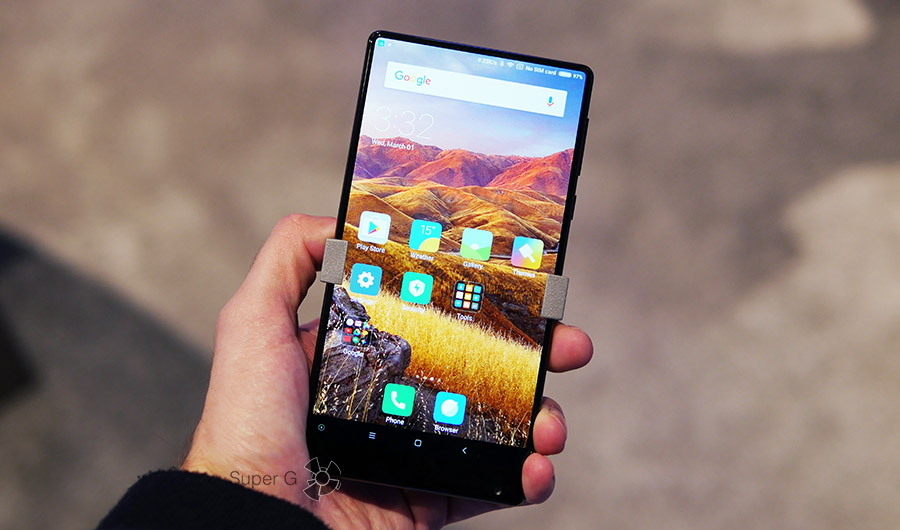
However, in real life Still, a small, but still not disappearing edge along the perimeter of the screen was discovered. There is no such thing in the S8 - the smartphone screen is rounded and flows somewhere beyond the boundaries of the smartphone. It seems as if the display extends onto the back of the device, but this, of course, is not the case.
So right from the start we started discussing the main feature of the device - a 5.8-inch screen with a fierce resolution of 2960 by 1440 pixels. The dot density is simply off the charts - 570 dpi. It must be said that in terms of the last parameter, the youngest one outperforms its older brother S8+. Here the pixel density per square inch is 529 dpi, and the screen diagonal is 6.2 inches. The resolution in both devices is the same and is cleverly called Quad HD+. We memorize the new term and then show it off to owners of outdated iPhones on all sides.
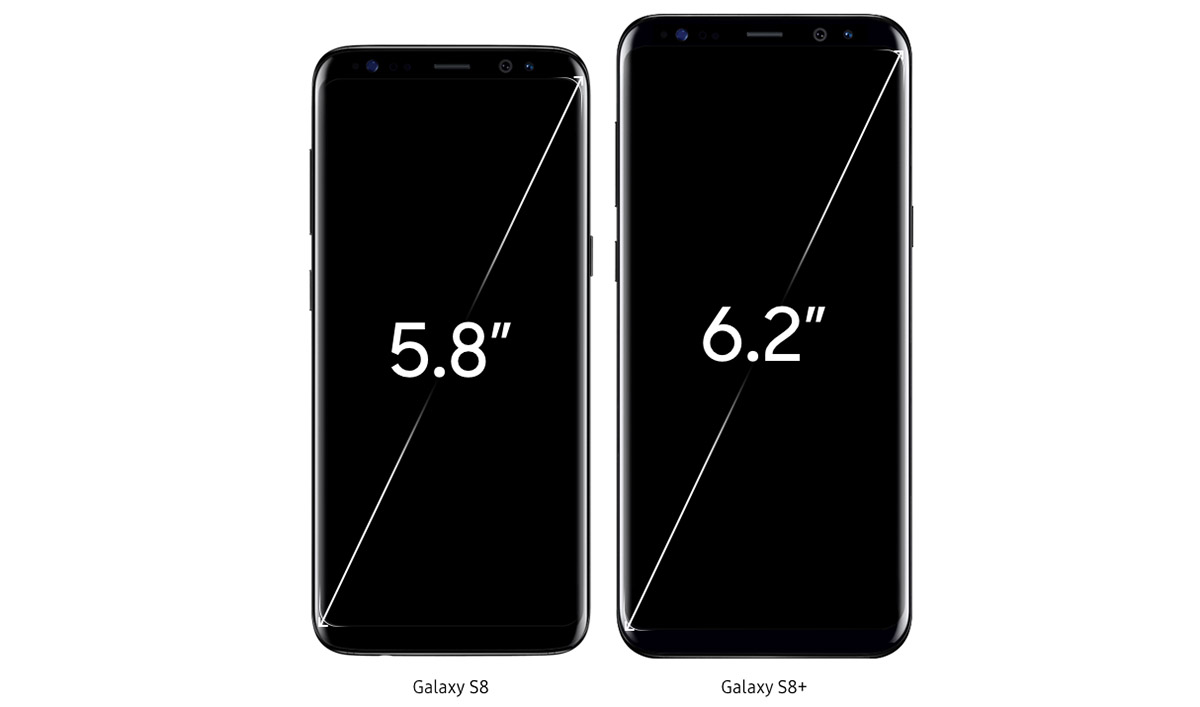
By the way, this resolution is another step towards improving picture quality in VR headsets. Not a leap, of course, but already something on the way to getting rid of the terrible pixelation in virtual reality headsets.
The difference in screen diagonals could not but affect the dimensions, so this parameter may be critical for some. Let's look at the comparison table below to imagine how spade-shaped the new products are...
| Length | Width | Thickness | Weight | |
| Samsung Galaxy S8 (5.8’’) |
148,9 |
68,1 |
||
| Samsung Galaxy S8+ (6.2’’) |
159,5 |
73,4 |
||
| iPhone 7 (4.7’’) |
138,3 |
67,1 |
||
| iPhone 7 Plus (5.5’’) |
158,2 |
77,9 |
||
| Huawei Mate 9 (5.9’’) |
156,9 |
78,9 |
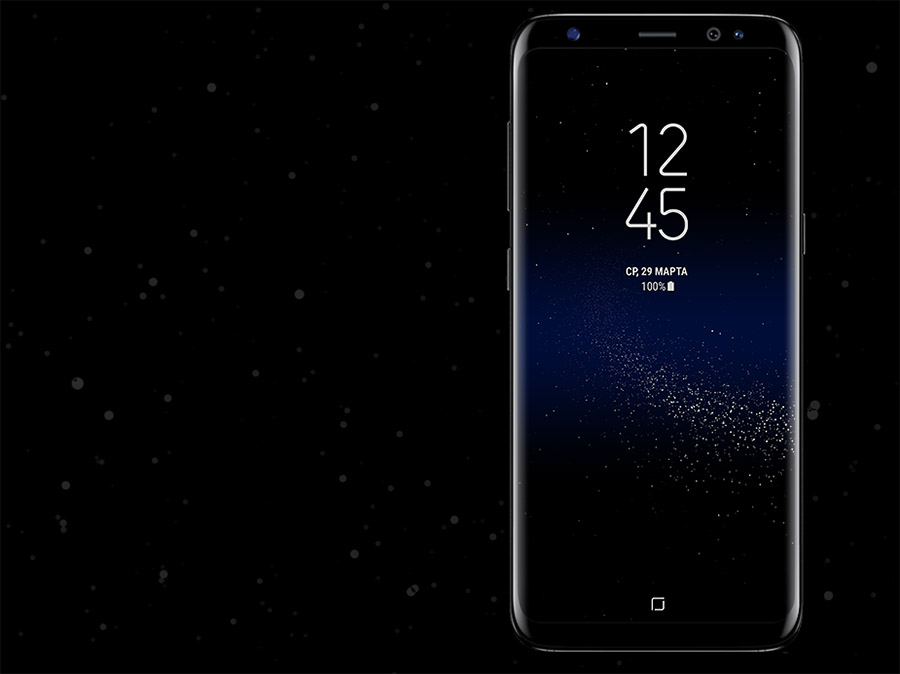
By the way! Since our display is “unlimited” (as the company calls it), there was no room for a physical home button at the bottom. All buttons are now on-screen. Many people hate this approach, but the guys from Samsung assured that everything here is implemented in a smart way. When you need them, they are there, when you don’t need them, they are not there. Well, we need to check it in practice.
The new products, just presented in New York, are the first in the world among mobile devices received an Exynos 9 processor (model 8895), created using a 10-nanometer process technology in-house. Depending on the region, devices will receive a chip either of their own production or Qualcomm Snapdragon 835. We, residents of Russia, will rejoice at the performance of the South Korean processor.
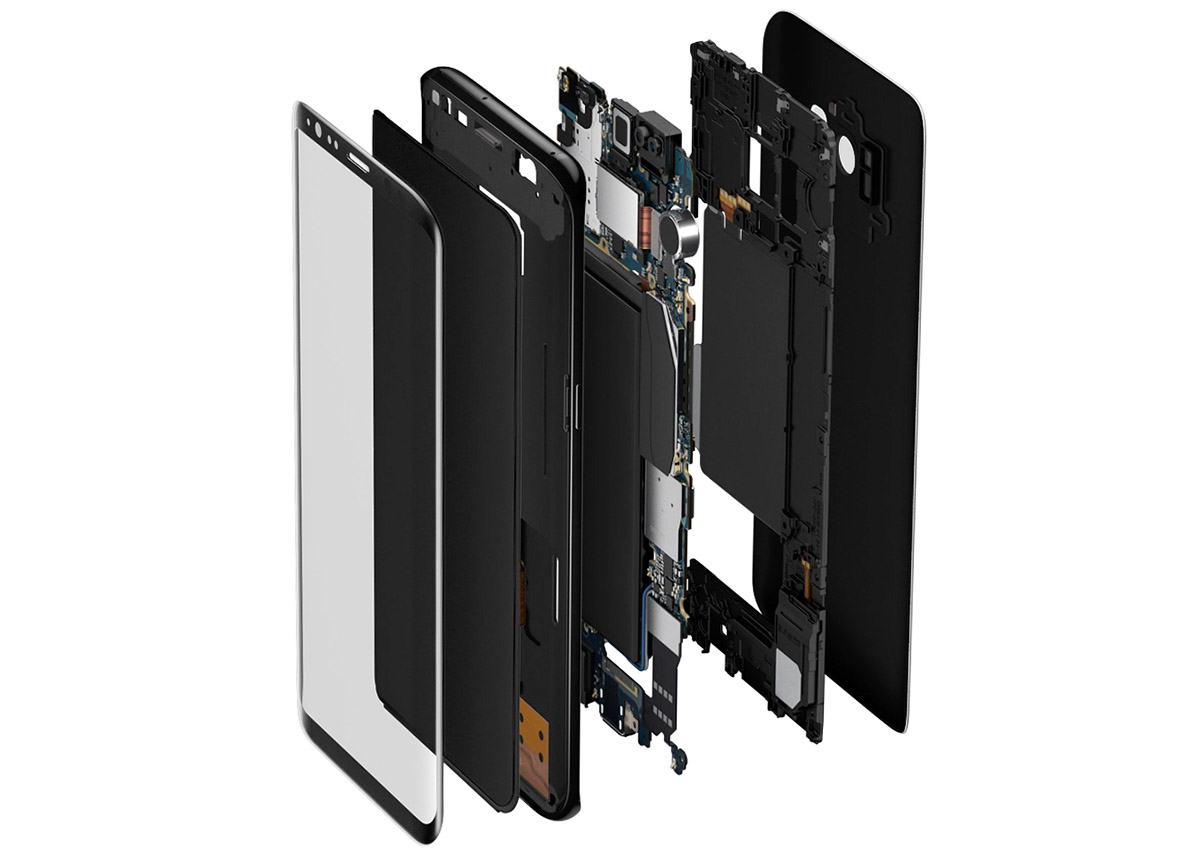
In addition, the “stone” includes a modem with support for LTE Cat. 16, which will allow you to pump data from the network at speeds of up to 1 gigabit. An absolute record to date. All that's left to do is find one cellular coverage- no big deal!
Most fans of the brand have special hopes for the camera of the device. The release of the next Galaxy revision raises the bar for quality mobile photography and that's the rule. So far we only have numbers and promises, but I am sure that this year was no exception. Thus, the G8 received an 8-megapixel front camera with a record f/1.7 aperture for this module and autofocus. Samsung calls it intelligent, apparently, it can detect faces in the frame, gender, age, amount of money in the bank, and so on.
At the back there is a 12-megapixel photosensor with the same f/1.7 aperture and Dual Pixel technology - more light reaches each point on the matrix. And yes, the camera no longer sticks out and this is perhaps one of the coolest achievements. I'm serious!
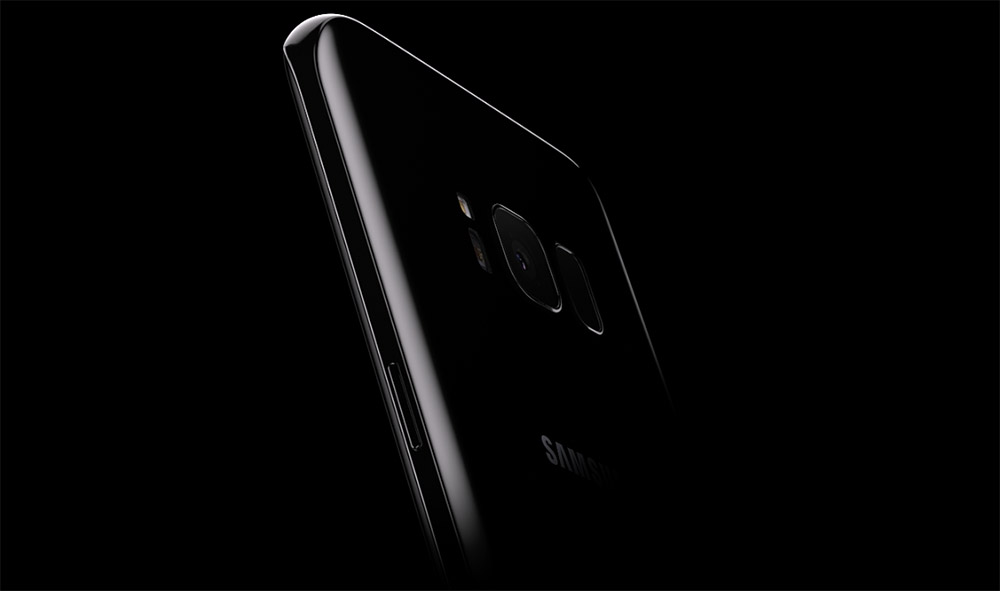
Another indisputable advantage of gadgets from the South Korean giant is the security provided by the Knox platform. Now the device can be protected not only with a PIN code, fingerprint, but with a unique “pattern” of your own iris. A special Iris scanner is installed on the front of the smartphone, which scans the iris and at the same time recognizes the owner by facial features that are characteristic only of him.
If anything, the fingerprint sensor has moved to back cover smartphone. In general, this is not very convenient, but we have an Always On Display and an Iris scanner, so you won’t have to touch your smartphone again.
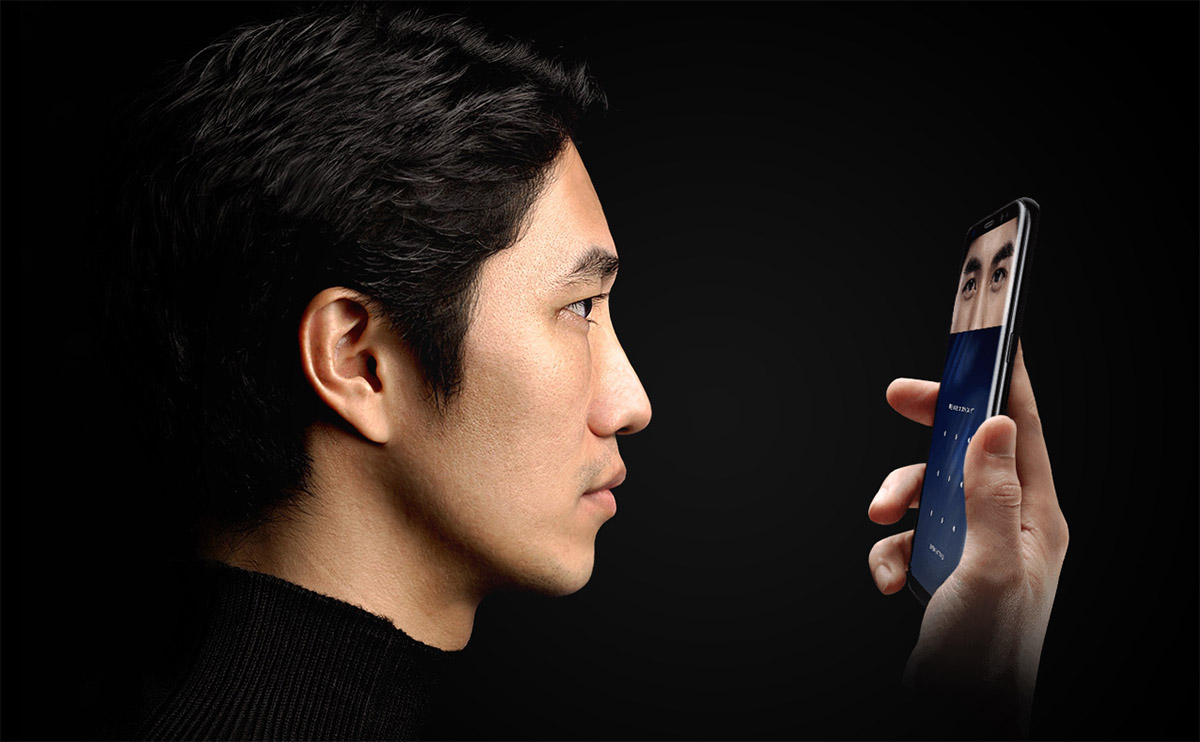
The new product will also mark the release of another feature - intelligent assistant Bixby. It's not just a competitor to Siri or Cortana (although it's not a competitor to anyone at all), it's a system integrated into the OS and user behavior. The assistant evaluates what you do on your smartphone, how you do it, where, when, and helps you make certain decisions, helps you search for what the user needs, and so on. Another attempt to create something similar to AI, which, of course, will be terribly stupid at first. However, it is better to try to do something than to just sit idly by.
Bixby will be introduced in Russia a little later. No one can say when yet, but there must be support.
Of course, such chips as:
- protection against moisture and dust according to IP68 standard
- wireless payments Samsung Pay
- support for Micro SD cards up to 256 GB (the manufacturer scared people with the release of S6 and S6 Edge, so now this parameter is highlighted separately)
- BB charging support (fast and wireless)
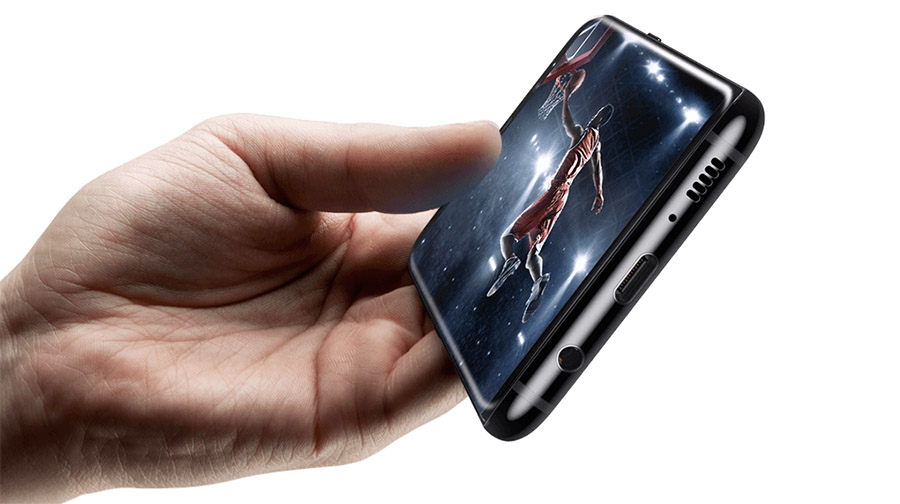
The 3.5 mm audio jack is still there. It's gratifying that Samsung developers are on friendly terms and left the port untouched. Nearby, that is, at the lower end, there is also USB Type-C. In the last generation there was Micro USB, but now, apparently, they considered that the time had come.
Technical Samsung specifications Galaxy S8(model SM-G950) And Galaxy S8 Plus (SM-G955) it’s best to compare by pitting both devices head-on. Let's get started.
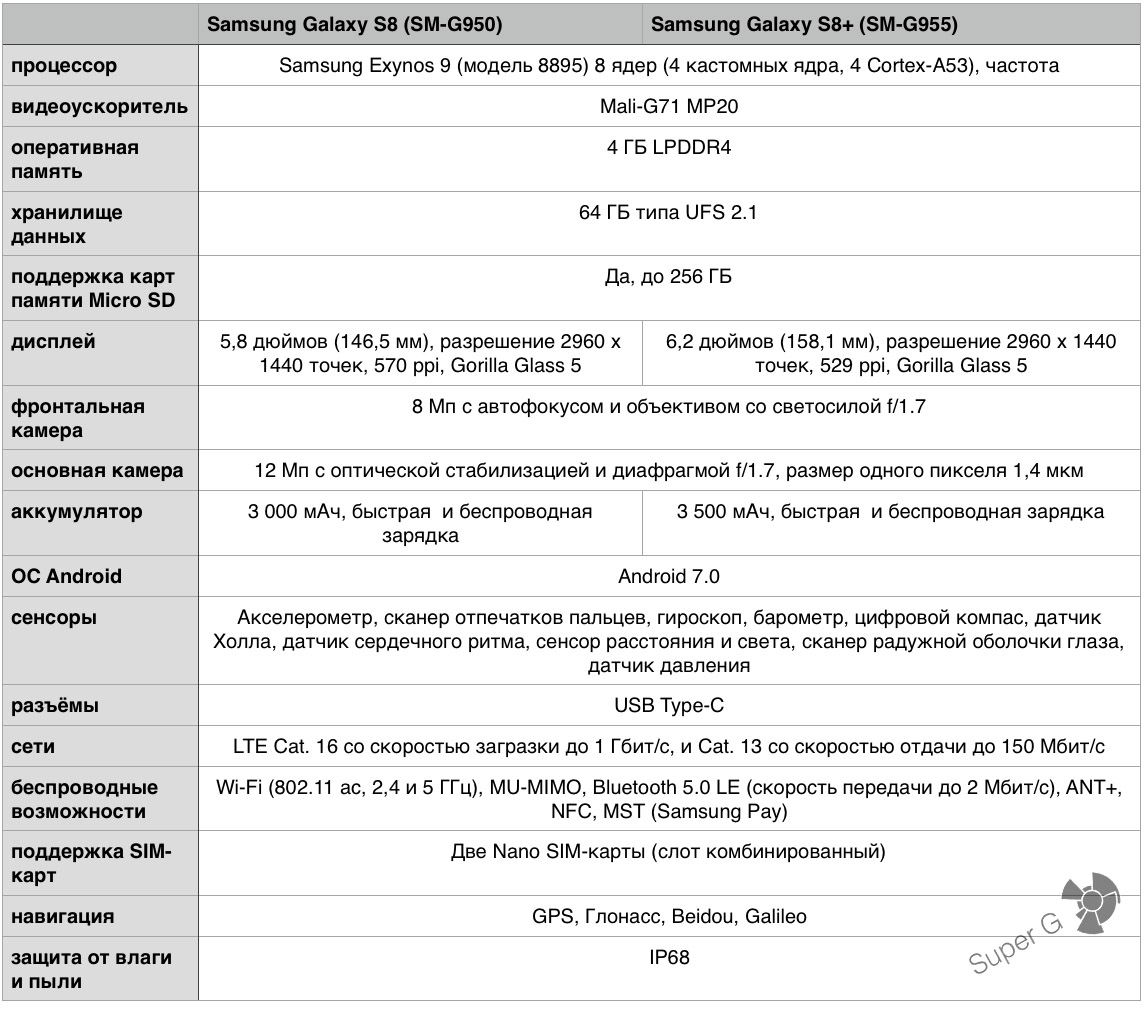
As you can see, differences between Samsung Galaxy S8 and S8+ not much. For the “flattened” version bigger screen and battery. There are no other differences.
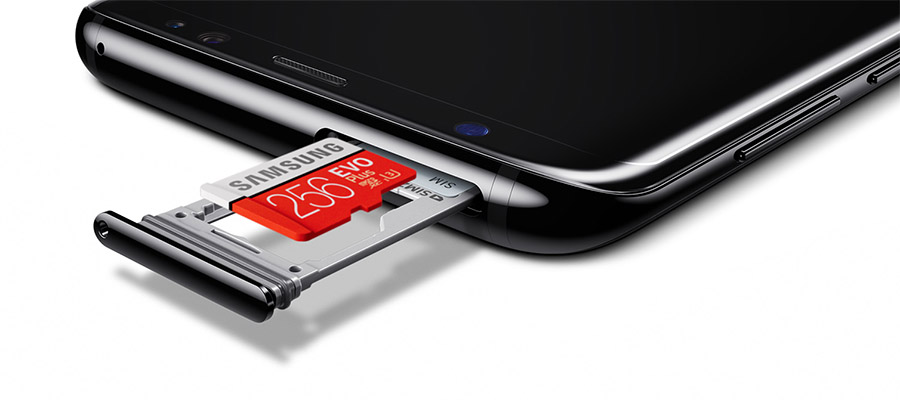
Since the giant Harman company is now owned by Samsung, it’s not a sin to equip your top-end device with normal headphones. In the kit, future owners will be able to find a dual-driver headset from AKG (a subsidiary of Harman). “Unique sound quality”, noise reduction, advanced cable braiding - everything is in place.
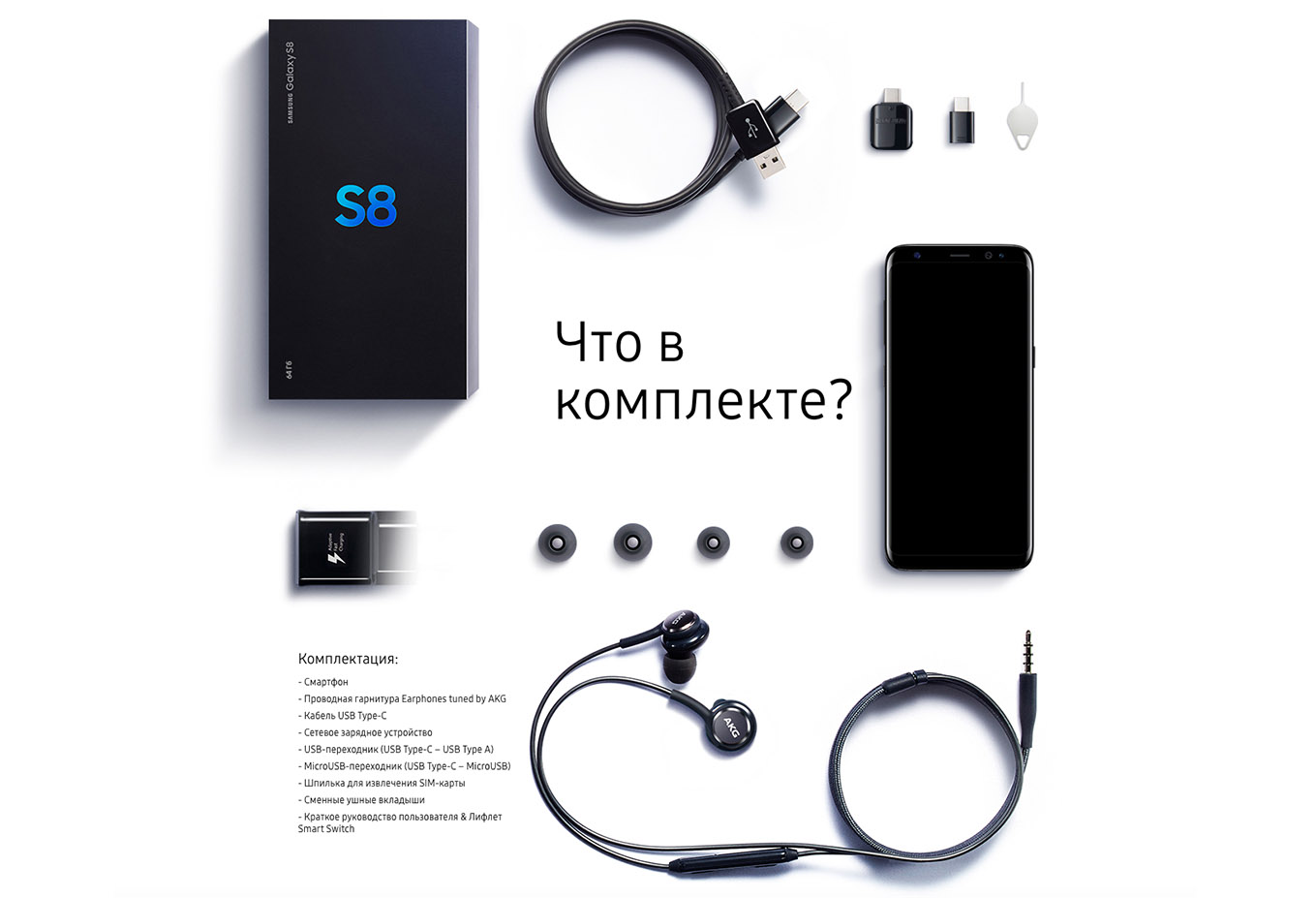
I'm sure you're already itching to know "when?" and “how much?” I answer! Start of sales of Samsung Galaxy S8 and Galaxy S8+ in Russia scheduled for the second half of April. To be more precise, it will be April 28, 2017. However, those who ordered and paid for the new product on the official website will receive their devices before this date. They will also receive a gift in the form of a 360-degree samsung cameras Gear 360.
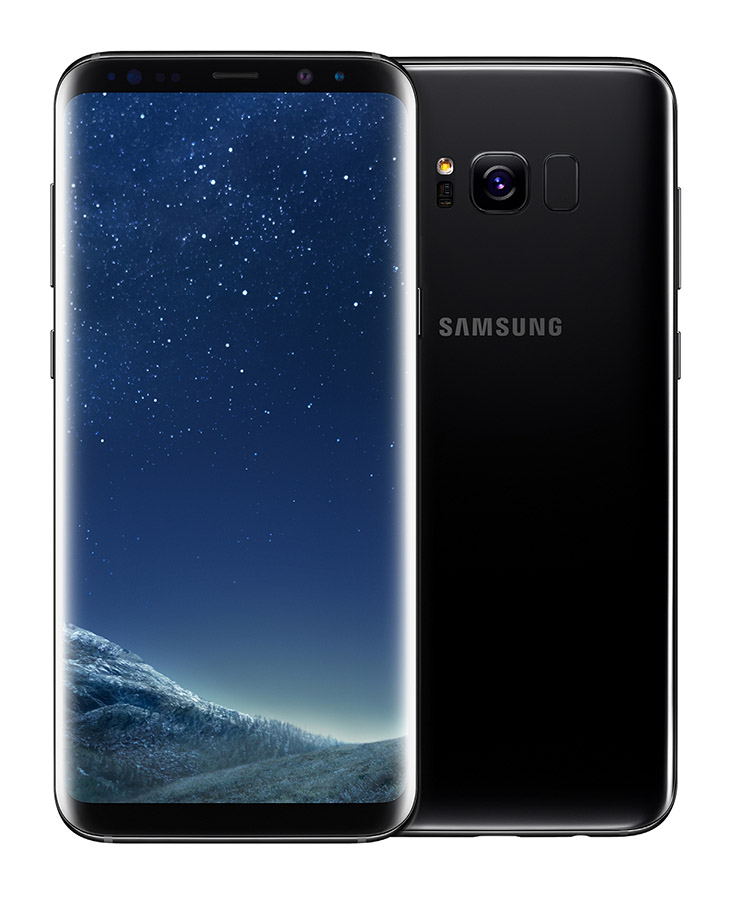
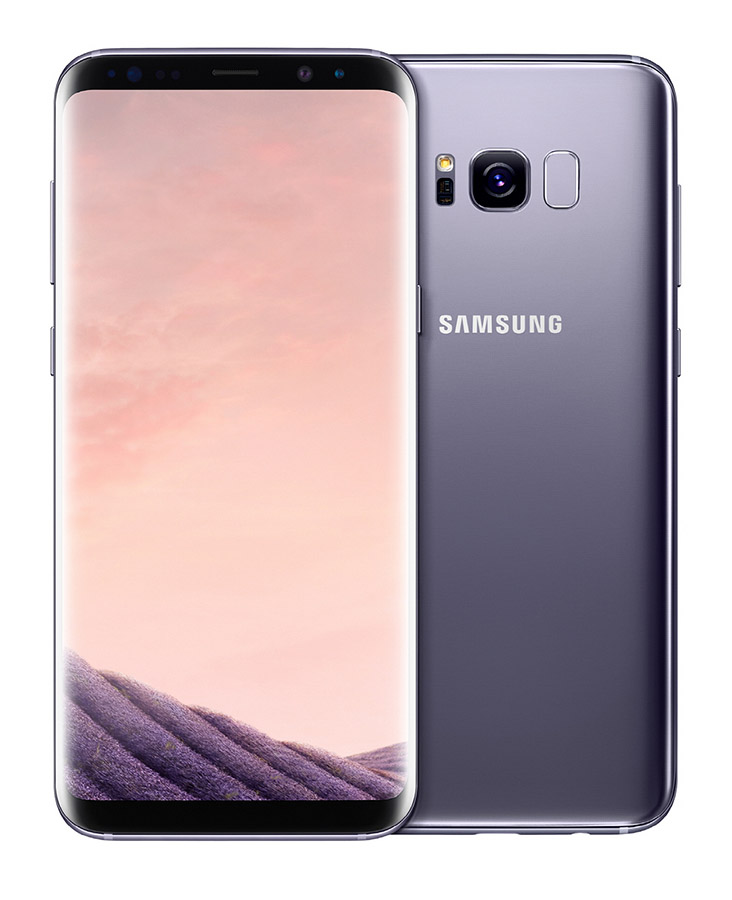
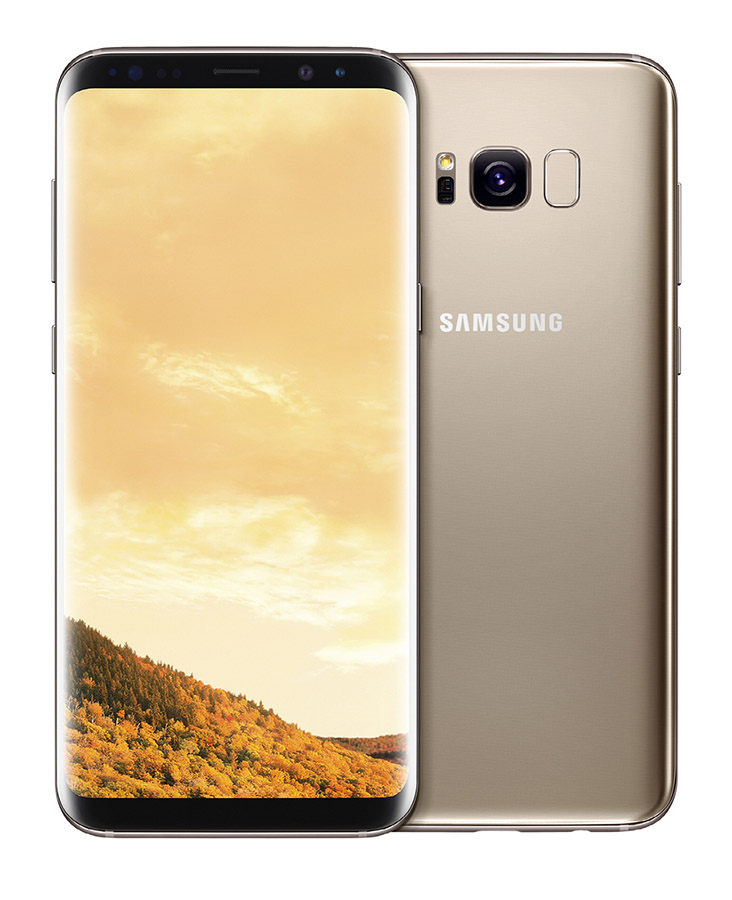
At first, it will be available in three colors: black, amethyst (somewhere between pink and purple) and gold.
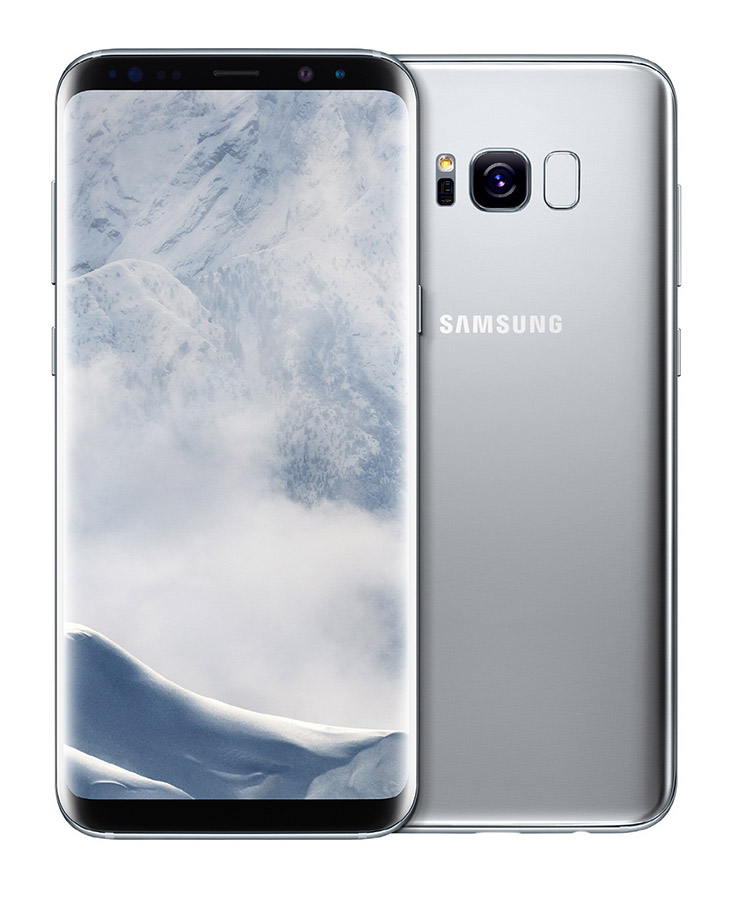
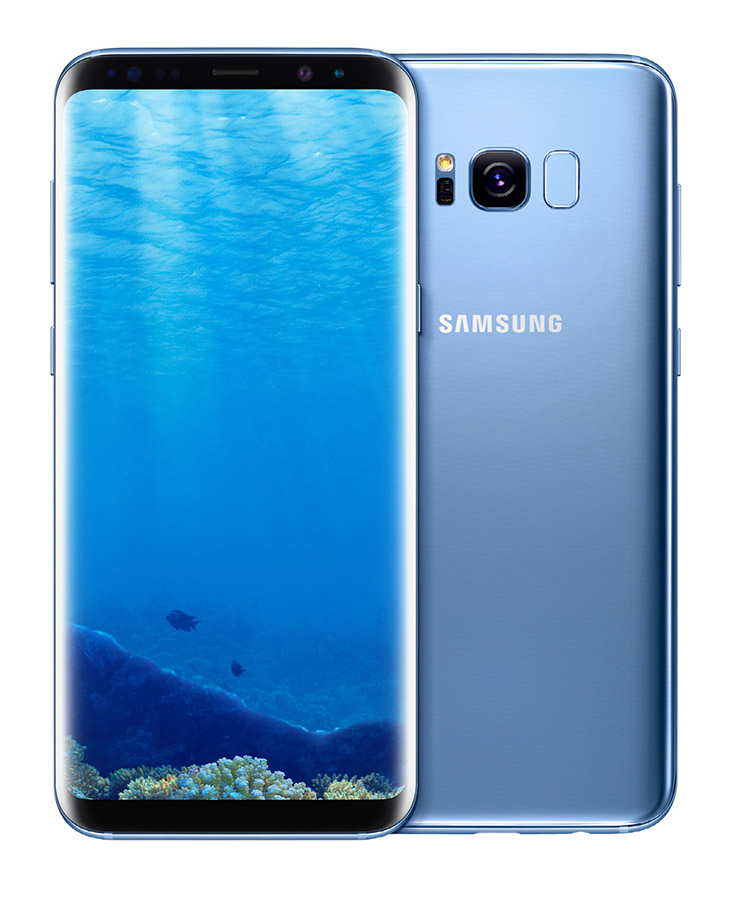
Later there is a chance that two more colors will be added: silver and blue ( Galaxy Note 7, hello!).
Well, the most interesting thing is the prices. Buy Samsung Galaxy S8 it will be possible for 54,990 rubles, and the older modification, that is, Galaxy S8+, will be sold for 59,990 rubles. Prices are higher than direct competitors like 7 Plus. On the other hand, you put both of these competitors side by side. Well?! I hope everything is clear?
Dima Grishin Author of 3 reviews
Problem solved
Advantages: 1) The screen, this is the most important thing for me in a phone and there are no competitors here, (considering that the 8th iPhone will have a screen from Samsung and not curved) it won’t be in the near future. Looking at the screen of the 7th iPhone is just funny, it infuriates and frames and its lower saturation ( Super AMOLED Samsa does a great job!) 2) Design! it is divine 3) Samsung Pay (namely the presence of the MST chip) - you can pay even if the pin pad does not support payment via NFC 4) Ease of use/size - due to the fact that the phone is narrow and long (sausage) it is very convenient to use and it fits perfectly in the hand with a huge screen diagonal, compared to iPhone Plus series (5.5") which is very uncomfortable to grasp with your palm, while the S8 has 5.8" and it is very comfortable! a frameless screen is simply a breakthrough of the year! 5) Performance - heavy games I don’t launch it, but everything flies, nothing lags, not even a single glitch, there weren’t even micro-micro glitches 6) WOW - effect 7) Camera - although I’m not a fan, but when you show the pictures to friends and they ask what you shot with, they don’t believe it that it was a phone... 9) A bunch of sensors/sensors - the retinal scanner works instantly! 10) Water resistance - 30 minutes at 1.5 meters deep... and there is no such thing as an iPhone 11) Wireless charging - I finally forgot what wires are! iPhone hasn’t dreamed of this yet... although Samsung got it a few years ago Disadvantages: 1) Bixby - a button that I disabled, they promised to outshine Siri... but until it speaks Russian it just doesn’t make sense, and the services hang and eat battery, although it’s not noticeable, but still 2) Heating - the processor’s technical process is already 10nm, but the phone in games is as hot as my grandmother’s pies! (my version is on Exynos processor). But I got used to it on S4, but the discomfort is still there! 3) The lack of a stereo speaker like in the iPhone 7, although this is of course a big detail, but still! 4) Fingerprint sensor, of course, they did everything they could! but it’s really not very convenient, but also not as inconvenient as many people write! you can get used to it 5) Home button occasionally glitches when waking up the phone from sleep mode... it’s a software bug for many 6) Oleophobia - it started to wear off after 3 weeks, but the phone was in very aggressive conditions.. and this, alas, is not a defect, I think I would have had it with any phone, BUT it was in the 5th Gorrilla Glass that there were problems with applying oleophobic coating and this problem surfaced - due to the lack of buttons, it is difficult to understand by touch where the phone is up and where is down! sometimes (especially when I’m drunk) I point at the virtual button and can’t understand why it doesn’t work! Comment: Well, with all the pros and cons, obviously - S8 best phone on the market, well, it’s true that Note 8 came out, but it’s already a phablet, not a smartphone. Compared to the S8, iPhones look like backward dinosaurs, in all respects (except for iOS)... Clearly, Apple knows this and is preparing a serious answer in the form of the iPhone 8 B too time and Samsung understands that their phones are already superior to their competitors in many ways and are increasing the price tag on their handsets like taxi drivers at the Moscow airport, which is also not good! In general, the phone is really very good, but you should beware of defects! read the 4pda thread - defect/repair section and understand what needs to be checked before purchasing. I am very glad that I took this particular phone! Happy shopping to you!
Another holiday has come for fans of the Samsung brand; two wonderful smartphones will go on sale at once - Samsung Galaxy S8 and Galaxy S8+. Being followers of the Galaxy S7 and direct competitors of the Apple iPhone 7, both devices are worthy of their owners. The convenient design and powerful hardware of the Galaxy S8 are impressive, which is worth talking about in more detail.
Design and interface
Touching and swiping, pinch and spread your fingers - all this is included in the properties of the touchscreen interface. Changing applications is improved by 3D Touch technology, which distinguishes the pressure of fingers (Peek, Pop). All electronic components are enclosed in a durable glass case, and the display measures 5.8 inches diagonally. The front panel belongs almost entirely to the screen, the edges of which are rounded even to the side edges. A small strip is left at the top, on which you can see the peephole of the 12 MP main camera and the double flash LED. On the rear panel front camera 8 MP, light flash and biometric scanner. Below is the brand's signature inscription. By color scheme Samsung Galaxy S8 It will be available in only three variants: dark black, orchid gray and silver. But even this choice is quite enough not to miss the moment of purchase.
The innovation of the device includes the use DeX docking stations, connection to which is carried out with a USB Type-C cable. The emergence of additional HDMI output and two USB ports significantly expand the functionality of the gadget like a PC. Another useful assistant is the Bixby option - voice command assistant.
OS and more
Android platform, even latest generation, the content is somewhat different from the “Apple” indicators of iOS, in some moments even surpassing its competitor. The proprietary processor (for Russia) is represented by the Exynos 8895 brand; for the USA it will be replaced by the Snapdragon 835 from Qualcomm. According to its main parameters, it is designed for 4 GB of RAM, while the main one will not exceed 64 GB. Expansion via microchip 128/256 GB is allowed. Responsibility for graphics support rests with the Mali G71 accelerator, which is quite sufficient for high-quality images not only text information, but also photos and video materials. Performance is also possible thanks to the presence of universal Flash Storage, with the built-in Generation of the second version.
Quite recently, two new “space” devices appeared on the mobile device market. Samsung flagship Galaxy S8 and its slightly larger version Galaxy S8+. It would seem that there is nothing else to chase, what other improvements can be put into these small devices. Apparently, Samsung, which was bound to happen sooner or later, also asked similar questions. Since after the breakthrough Galaxy S7 and S7 Edge in many ways, it has become pointless to technically improve gadgets, then where to go next? The South Korean developer has directed the development of its flagships along a new path. Namely, design and ease of use. Instead of trying to outplay their biggest competitor - the IPhone - developers from the country of Morning Freshness paid attention to the comfort of their own customers.
Specifications of Samsung Galaxy S8 and S8 Plus
In terms of technical features, the S8 and S8+ rightfully occupy a leading position not only among their own representatives, but also among the flagships of other brands. They outperform their younger predecessors quite a bit - S7 and S7 Edge. However, Samsung representatives themselves pay much more attention to the design of the phone and the various “tricks” that appeared here. So let's take a look at what's here.
Housing materials
The phone body, like most modern Samsungs, is made of glass and metal. The frame that frames the perimeter is metal, and the front and back panels are completely hidden under the glass. By the way, the S8 has Gorilla Glass 4, but the “baby” S8+ is protected by Gorilla Glass 5. Both have an oleophobic coating, which means that the phones are protected from minor scratches, dust and do not glare in the sun. And at the same time extremely easily soiled. It’s better to immediately purchase a case for your new gadget, otherwise you risk going crazy trying to get rid of instantly appearing and omnipresent fingerprints on the case.
The phone is very pleasant to hold in your hand, but it gets dirty at the speed of light
Design
The materials of the S8/S8+ are not much different from their predecessors, but there have been dramatic changes in design. Now the working screen occupies almost the entire surface of the front panel - as much as 84% of its area. The speaker, retinal scanner, proximity sensor, front camera and light sensor remain in place. Do you understand what this means? No mechanical button“Home” and the famous Samsung logo above the display. “Home” button, as well as touch “Return” and “ Running applications” have now become part of the screen. These “managers” retained their functions. The virtual Home key is located in its usual place and is always available to the user. The feeling of pressing it is exactly the same as pressing the previous physical version - you can feel a kind of click both when you press the key and when you release it. If you press this sensor with great force, it will vibrate and instantly take you to the main screen. For those who are concerned about the accessibility of the key during operation of various full screen programs, for example, games, let’s clarify - Home is always available.
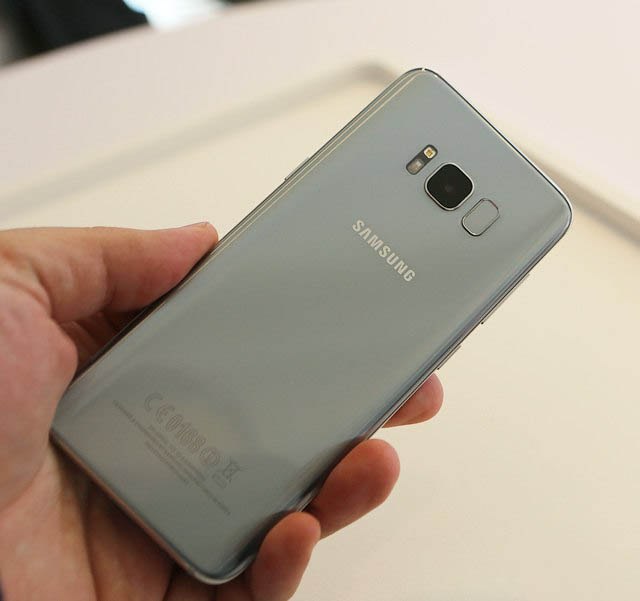
The fingerprint scanner had to be moved to the back panel, because there was simply no room left in front
On back side Along with the camera and flash, the developers placed a fingerprint scanner. Not all users were satisfied with this solution, however, you must admit, the creators simply had no alternatives.
Sizes and colors
The dimensions of the Samsung Galaxy S8 are 148.9 x 68.1 mm, and the height is 8 mm, while the weight is 152 g. The Samsung Galaxy S8 Plus is slightly larger than its counterpart: length and height - 159.5 x 73.4 mm, thickness - 8.1 mm, and weight - 173 g.
The dimensions of the phones, in general, do not feel too capacious or inconvenient. The devices fit perfectly in the hand. True, small flaws are revealed when trying to reach the S8+ fingerprint scanner. If in the S8 the sensor button can be found without much difficulty, then in the Plus model this becomes a significant task. Otherwise, the ergonomics of the devices perform well.
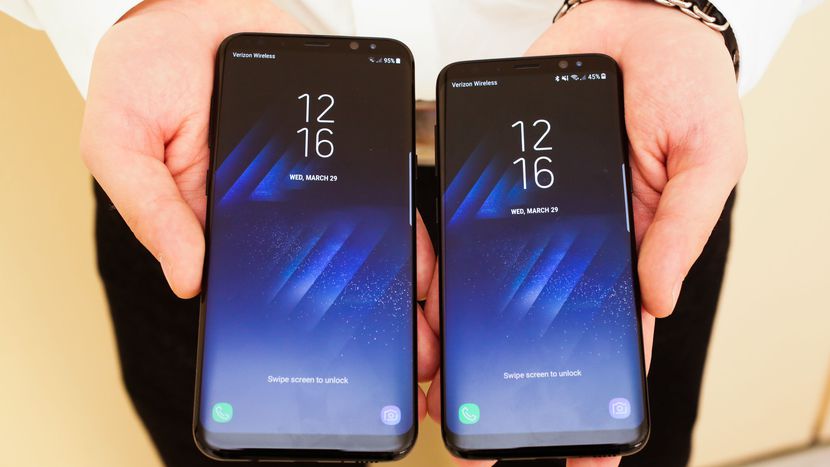
Despite their rather large size, both phones fit perfectly in the hand. But trying to reach the opposite upper corner is in vain
The phones have five colors, but only three are available for Russia: yellow topaz (gold), black diamond and mystical amethyst (silver).
Screen
The screen is the most remarkable part of the phone, because it takes up almost the entire space of the front panel. Diagonal size regular version 5.8 inches with a pixel density of 570 ppi, the plus model has 6.2 inches with a pixel density of 529 ppi. The screen resolution is 2960 x 1440 pixels, i.e. Quad HD+. The screen, of course, has curved edges, just like the Galaxy S7/S7 Edge. However, this time the developers tried to make the display “limitless” and they really succeeded.
Due to the fact that the side frames in the front plane of the screen have disappeared, and the upper edges on both sides of the display are extremely narrow, an unusual feeling is created as if you are immersed in the image. In addition to this, the slightly elongated proportions of the screen add originality to the phone. It uses an 18.5:9 ratio instead of the usual 16:9. Surprisingly, such an innovation does not cause any discomfort. Quite the contrary. Now the screen can accommodate much more information, which is certainly convenient. And such an unusual display of the picture only adds to its uniqueness.
Both versions of the phone use the same type of SuperAMOLED screen. If you have already used phones from Samsung average and older lines, then you know about all the advantages of this type of screen. You still have access to various detailed settings - color mode, calibration, filter blue, contrast, brightness, etc. The screen performs well both indoors and on a brightly lit street. Among other things, in the screen settings you can set the desired resolution and the list of applications that will be used in full screen mode.
Photo gallery: smartphone display testing
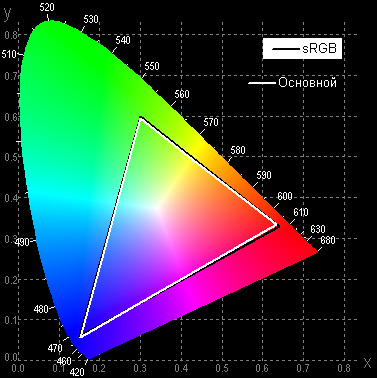 In the main mode, colors are as close as possible to sRGB values. When changing modes to other ones, the color gamut changes depending on the tasks of the assigned profile. Screen settings are very flexible - you can easily adjust the display to your own perception. The blue color filter will reduce the strain that the bright display of phones puts on your eyes. By default, the screen resolution is HD+ quality, but you can easily increase it. It is worth noting that the changes are almost invisible, because even in HD, the picture on the display is as clear as possible. Among other things, you have the opportunity to independently choose the way in which certain applications will be displayed
In the main mode, colors are as close as possible to sRGB values. When changing modes to other ones, the color gamut changes depending on the tasks of the assigned profile. Screen settings are very flexible - you can easily adjust the display to your own perception. The blue color filter will reduce the strain that the bright display of phones puts on your eyes. By default, the screen resolution is HD+ quality, but you can easily increase it. It is worth noting that the changes are almost invisible, because even in HD, the picture on the display is as clear as possible. Among other things, you have the opportunity to independently choose the way in which certain applications will be displayed
Processors
Both the phones are powered by the octa-core Samsung Exynos 8895 Octa SoC chipset. Its uniqueness is that it is the first processor created using a 10-nanometer process technology. The chipset consists of four cores Exynos M2 Mongoose with a clock frequency of 2.5 GHz - the South Korean company's own development - and four ARM Cortex-A53 cores with a frequency of 1.7 GHz. They also placed a powerful GPU Mali-G71 MP20 with Vulkan API support. Now processors have become more compact, more powerful, heat less and use batteries more wisely.
System
The South Korean developer decided to abandon the already familiar TouchWiz shell. Instead, Android 7.0 called Nougat is now installed on smartphones and a unique Samsung system Experience.
It’s difficult to track the speed and quality of work without tests, because the phone copes with any task without any problems, no matter how resource-intensive it is. Neither 3D games nor multi-window mode cause problems. One of the most pleasant moments is that the device responds extremely quickly to touches. Even in the top-end S7 and S7 Edge, the gadget's response time took a noticeable 1-2 seconds. S8/S8+ can boast of almost instant response.
Photo gallery: capabilities of Samsung Galaxy S8/S8+ processors and the subtleties of the new shell
Samsung Galaxy S8/S8+ has the most fresh android and proprietary system shell from Samsung The new shell is missing familiar button menu, but you can easily return it in the settings The DayLife panel is a very convenient assistant, but if you wish, you can easily turn it off Or customize it to suit your taste and interests Tests of the processor performance of both phones show simply cosmic numbers For reference - even the famous S7/S7 Edge in synthetic tests did not exceed 50k The test results clearly show how the new Galaxy are ahead of their colleagues on the market. As you can see for yourself, these South Korean phones have practically no equal. Such high indicators indicate that the phone can be loaded with any tasks - it will cope with everything perfectly. This screenshot shows the results of a test on the phone's response speed - the system just “flies”
Connection
As for communications, the phones support all the most common and advanced technologies. at the moment technologies such as LTE Cat.16, LTE FDD and TDD LTE. The connector for USB version 3.0 is used, i.e. extremely convenient two-way Type C input. In addition It is possible to use two Wi-Fi bands at 2.5 and 5 GHz, and Bluetooth 5.0 LE is also installed here. All this suggests that the speed of data transfer in absolutely any way will occur accurately and quickly.
Memory
There is no difference in memory capacity between both versions, so you don’t have to be torn between choosing between “a little more” and “a little less”. RAM in phones is the ideal middle ground of 4 GB, and the built-in one is 64 GB. Of these, only 1.6 GB of RAM and 52.3 built-in will remain freely available. The rest, of course, will go under system folders and files. However, even this volume should be enough for anyone. Well, in case these gigabytes still aren’t enough for you, you can sacrifice one of the two SIM cards and increase the phone’s capacity to 256 GB. That's for sure.
Battery
Another difference between the S8 and S8+ is the battery capacity. The first has a smaller one - 3000 mAh, while the second - 3500 mAh. The batteries on both devices are quite strong. A fully charged S8 battery, under conditions of moderate use of the device, will easily last you 2-3 days. The time of continuous work on the Internet ranges from 11 to 14 hours, the phone can play video for 16 hours, audio for up to 44 hours, and even up to 67 when the screen is off. Talk time can last up to 20 hours.
Samsung Galaxy S8/S8+ give you the opportunity to choose one of established modes energy consumption And also easy to set up
The S8+ is not much ahead of its counterpart: browsing the Internet is 13-15 hours, video is 18 hours, audio is 50 when the display is on and 78 when it is off, and talk time is up to a whole day.
Phones can be charged using wireless charging, and also use the accelerated battery recovery mode. In addition, there are several power consumption modes.
Other “chips”
Dust and moisture protection
The phone housing is made according to the IP68 standard. I think most Samsung users know that this standard guarantees your device protection from dust and moisture getting inside. This technology has been used by the Korean developer, starting with mid-class models, so it is not surprising that the company’s leading flagship also received IP68 protection.
Always-On-Display
As in previous models, the S8 and S8 Plus have extremely convenient feature Always-On-Display. When activated, even in sleep mode, notifications, calendar, clock, etc. are displayed on the phone screen important information. By the way, in the AON settings you can enable the display virtual button“Home” and then it will always be visible on the display along with other data.
Photo gallery: demonstration of the Always-On-Display mode and its settings
The AON function, as other smartphone models have shown, is very useful in everyday life. This time you will have even more settings. The most interesting thing is that no Samsung competitor has such technology yet
Bixby
Bixby is a built-in program that helps you control with voice, text or touch commands. various services and phone applications. This is a kind of Korean version of Siri from Apple. Bixby can collect and provide you with relevant information from the web, can give advice based on an analysis of your lifestyle, can translate text in an image, search by image, and even communicate with you. This pocket artificial intelligence independently studies the habits of its owner, remembers them and uses them in work. Unfortunately, at the moment the system only applies to English. Samsung representatives plan to provide Russian-language support by the end of 2017.
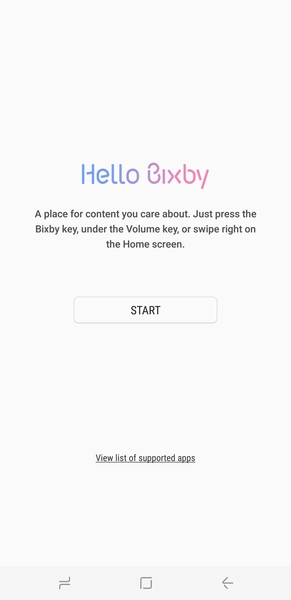
The intelligent assistant still needs improvement - at least in the Russian version
Biometric phone security
Facial recognition and an iris scanner have been added to the available data protection tools. In the first case, you need to take into account many different nuances. In good lighting, the sensor works perfectly and without failures. But if the light is dim or practically non-existent, don’t be surprised if your own phone suddenly doesn’t recognize you. Also, recognition may not work if, for example, you are trying to unlock your phone while lying down or your current appearance is somehow different from the one that was originally captured. In addition, many note that it is easy to deceive the scanner by simply showing it a photo of the owner. In the second case, recognition takes a little longer, but the tool is much more reliable.

The retinal scanner may act up if you are wearing sunglasses. The rest - including ordinary glasses - is not a hindrance to him
AKG headset
Samsung acquired Harman last year. This developer is famous for having previously created various audio products for brands such as Harman Kardon and Bowers & Wilkins. This time, Harman started collaborating with Samsung. The result of their work was in-ear headphones with remote control, designed and released specifically for S8 and S8+. We must pay tribute, the sound in them is really good. However, this is only at mid frequencies. Avid connoisseurs good sound They will clearly notice that the bass in these headphones is not very powerful, and there is no immersion effect or depth of sound either. And the volume of the AKG headset is very low. Maybe it's the phones themselves, you ask. But no. If you replace the headset included with any other more or less quality headphones, then the sound improves significantly. “Space” new products produce a simply gorgeous range of sound waves, but AKGs are definitely not suitable for revealing it.
Camera Features
Both phones inherited the camera from their top-end ancestor, the Galaxy S7. The resolution of the main lens is 12 megapixels, and the aperture is f/1.7. The front camera is a little worse - only 8 megapixels with an aperture value of the same f/1.7. Focus length is 26 mm, optical stabilization There is. In terms of technical strength, the camera is really no different from its predecessor. So what's new?
And the fact is that Samsung has focused on the software part of its cameras. Shooting in low light conditions has improved. The developers turned to Dual Pixel technology, which accelerated autofocus, as well as continuous shooting.
Daytime shooting (+photo examples)
When shooting during the day, there are no complaints about the camera. The pictures come out clear, highly detailed, without blur, even if the subject was in motion. The picture itself is rich, sometimes even too rich, but these are the features of all Samsung mobile equipment. The white balance is adjusted perfectly, the color gamut pleases with its maximum plausibility.
The phone copes with daytime shooting with a bang - all parameters show good results. Brightness and saturation do not let you down, and the color rendition is very close to natural. The phone adjusts the white balance very sensitively, with almost no mistakes. You can, of course, accuse the camera of a slight “repainting”, but it’s not looks critical, but only adds richness Detailing of even slightly shaking or moving objects is also good There are no complaints about macro photography In addition to other modes, the Samsung Galaxy S8/S8+ has the ability manual settings focus You can independently choose which view your phone should focus on
By the way, you can shoot in two modes - auto and manual. Manual mode allows you to adjust exposure, shutter speed, ISO, white balance. In addition, the S8/S8+ offers several preset modes to choose from. However, even without them the camera behaves quite decently.
Shooting in low light (photo)
We are already accustomed to the fact that in low light conditions, when it begins to get dark outside or you enter a room with your camera, the quality of shooting deteriorates sharply, the picture acquires a lot of noise, blurriness appears and saturation disappears. This does not happen in the case of the Galaxy S8/S8+. The phone takes excellent pictures even in dim light.
The picture was taken during the onset of evening - there is no noise, and the detail is as high as during daytime shooting. Saturation has not disappeared anywhere, the colors are bright and pleasant. The picture is no worse indoors - The colors are rich, there are no blurs, the brightness also copes with dim light. How do you You can see for yourself that the camera on the new Samsung Galaxy S8/S8+ is not inferior, but also superior to some DSLRs
Front camera
8 megapixels allow the front camera to take pictures with quality no worse than the main lens. It supports autofocus mode and auto face retouching. The camera does not have its own flash, but the screen backlight is a good substitute.

Even in dim light, the sculpture’s selfie came out detailed and rich.
Video
The maximum available resolution in which the S8/S8+ can shoot is 4K, i.e. 3840 x 2160 pixels, frame speed reaches 30fps. In the lower FullHD resolution, the frame rate increases to 60 fps. For video shooting, optical stabilization is available, which instantly straightens the frame. The phones produce an excellent picture - a decent level of saturation, brightness and detail even in the dark. Sound recording is also different high quality- there are no strange interferences or noises, the audio track is clear and loud.
The South Korean developer realized in time that it’s not a matter of pixels at all and “bigger” does not mean “better.” The camera on the S8/S8+ is not superior to the camera on the same S7, but the difference in shooting quality is noticeable.
And this video is a must watch if you want to have fun:
Design, dimensions, weight
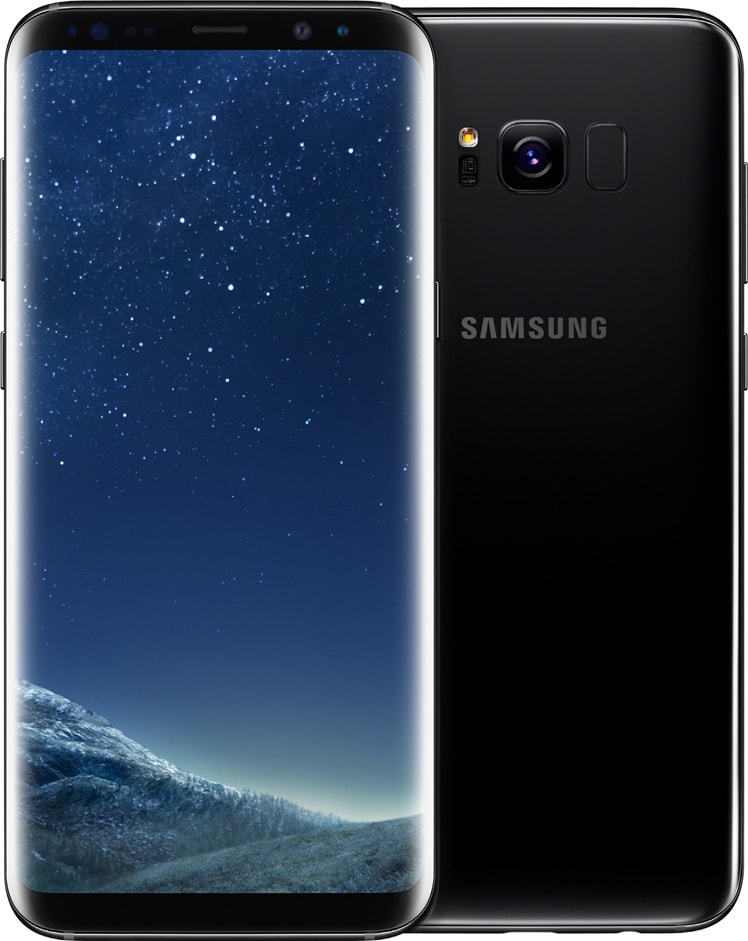
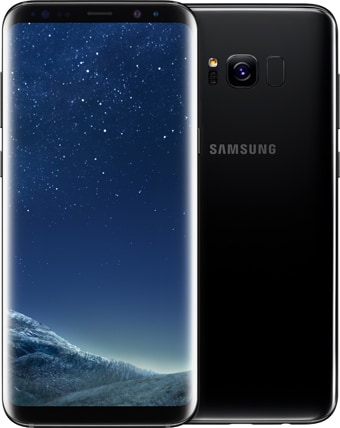
The new product has a premium look. Curved screen, minimal frames. This design looks fresh. Of course, the outlines of last year's flagship are recognizable, but this huge display, which occupies almost the entire front panel, and the absence of physical buttons on the front side make the design fundamentally different.
The freshness of the new design lies in the fact that the model looks transparent and weightless, because it is mainly the frames that add weight.
The Korean company uses the slogan for this model: “Smartphone without borders.” This ambiguity of the slogan really defines this device well.
This phone will really stand out. It looks expensive and stylish. Not to be confused with cheaper models.
S8 dimensions (in mm): 148.9 × 68.1 × 8.
S8+ dimensions (in mm): 159.5 × 73.4 × 8.1.
If we compare the dimensions with the previous generation of flagships, the new items have become noticeably taller, but the width has changed slightly. Regarding the smaller versions, the 2016 flagship was even a little wider.
S7 dimensions (in mm): 142.4 × 69.6 × 7.9.
S7 Edge Dimensions (in mm): 150.9 x 72.6 x 7.7.
Comparisons with other smartphones
Photos of sevens:
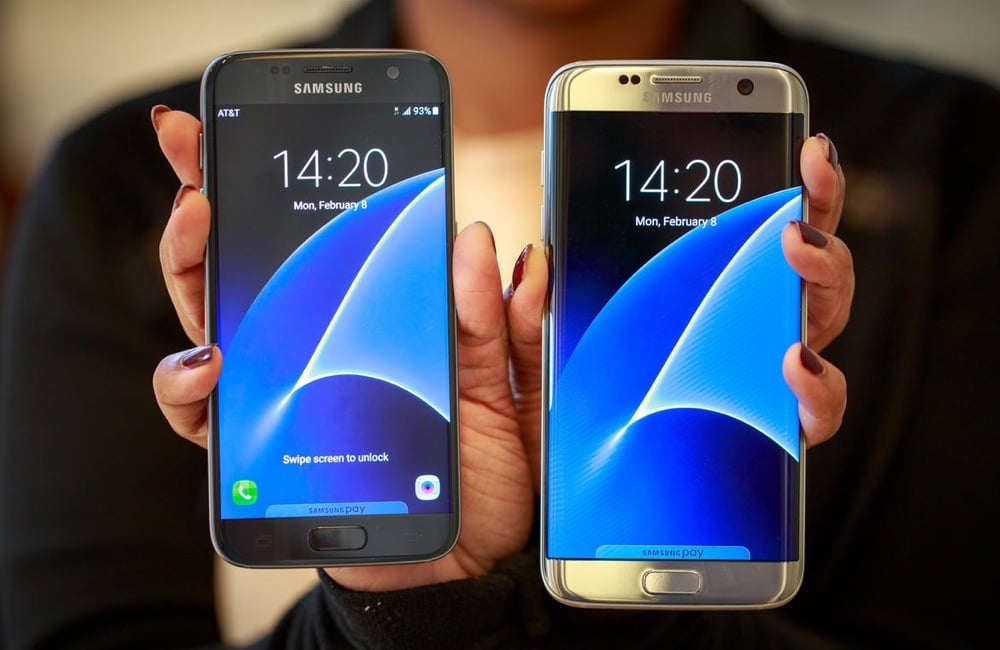
![]()
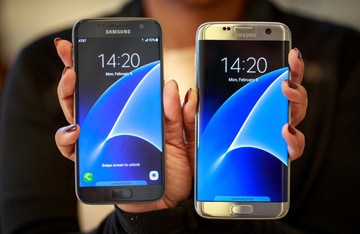
And then the eights:
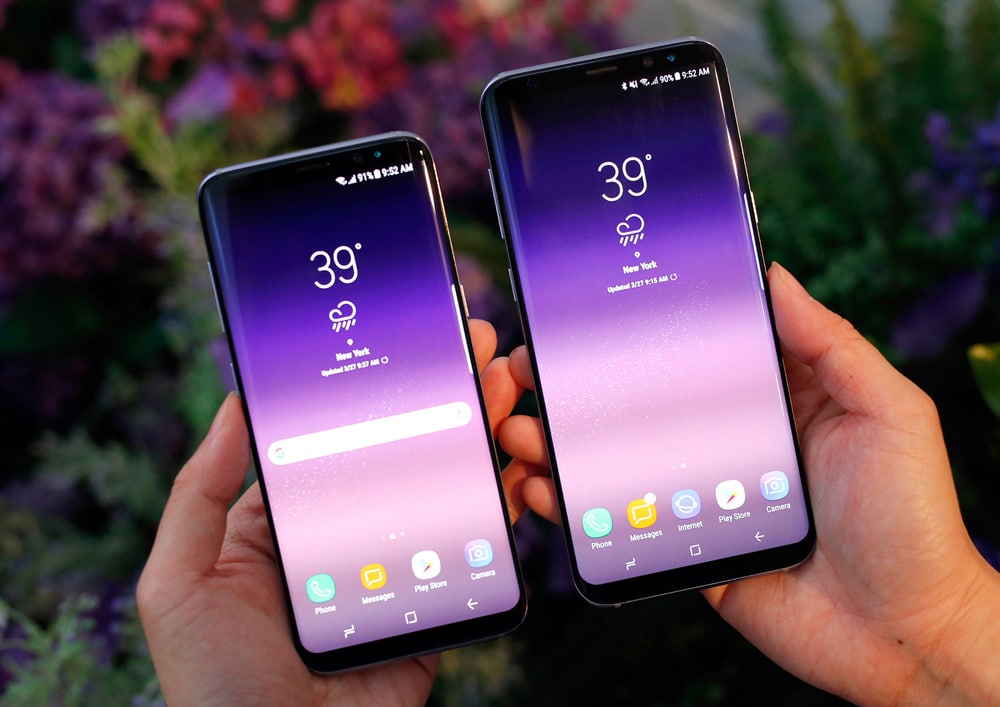

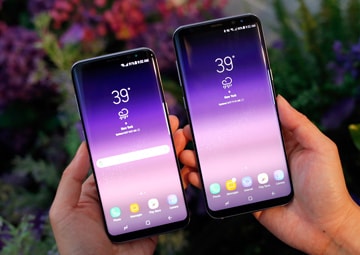
The weight of the 2017 flagship, or to be more precise, its mass, is 155 g and 173 g, respectively.
Some more comparisons?
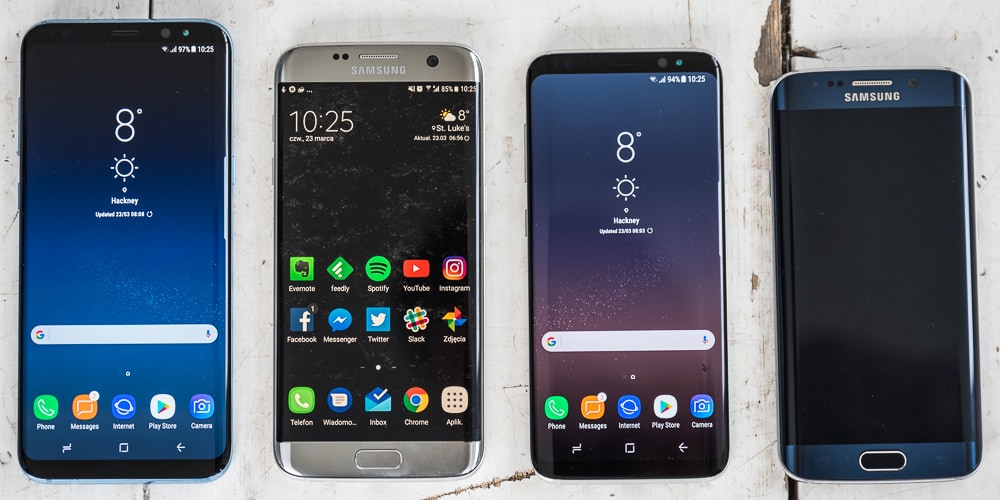
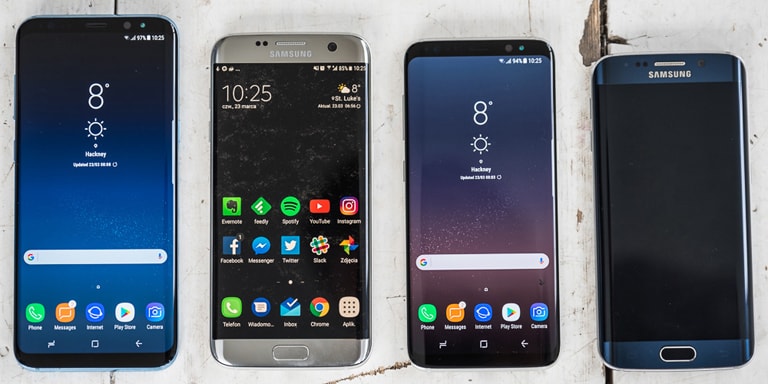

From left to right and by height: S8+, S7 edge, S8, S6 edge.
But Samsung Galaxy S8 Plus vs. Apple iPhone 7Plus:
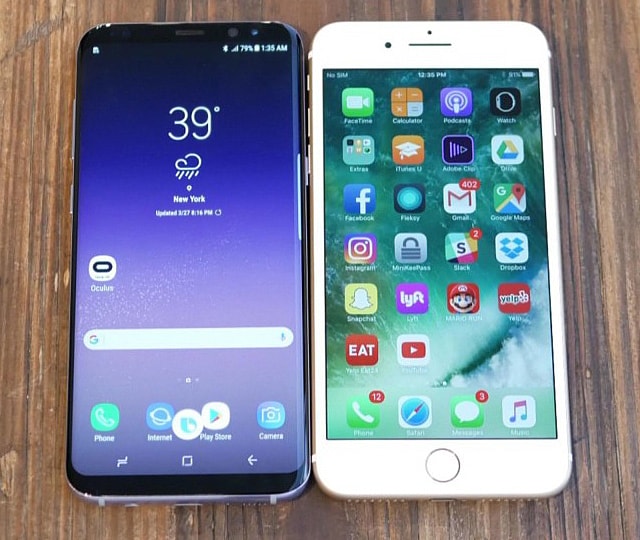
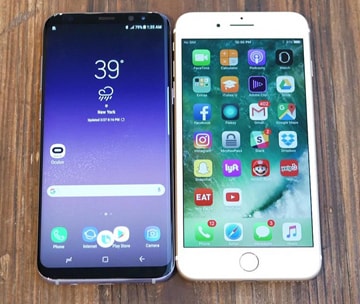
Agree, Samsung looks more elegant than iPhone.
Fingerprint scanner
Since there was no space left on the front panel due to the huge screen, the fingerprint scanner was moved to the rear panel. Now you need to unlock the phone not with your thumb, but with your index finger.
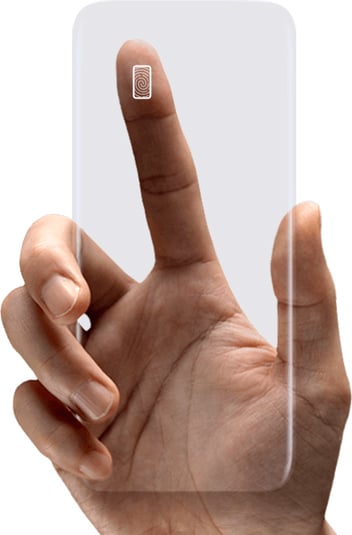
This is more of a minus than a plus. This will probably be less convenient, and when you fumble for the scanner, the camera lens that is located nearby may get dirty.
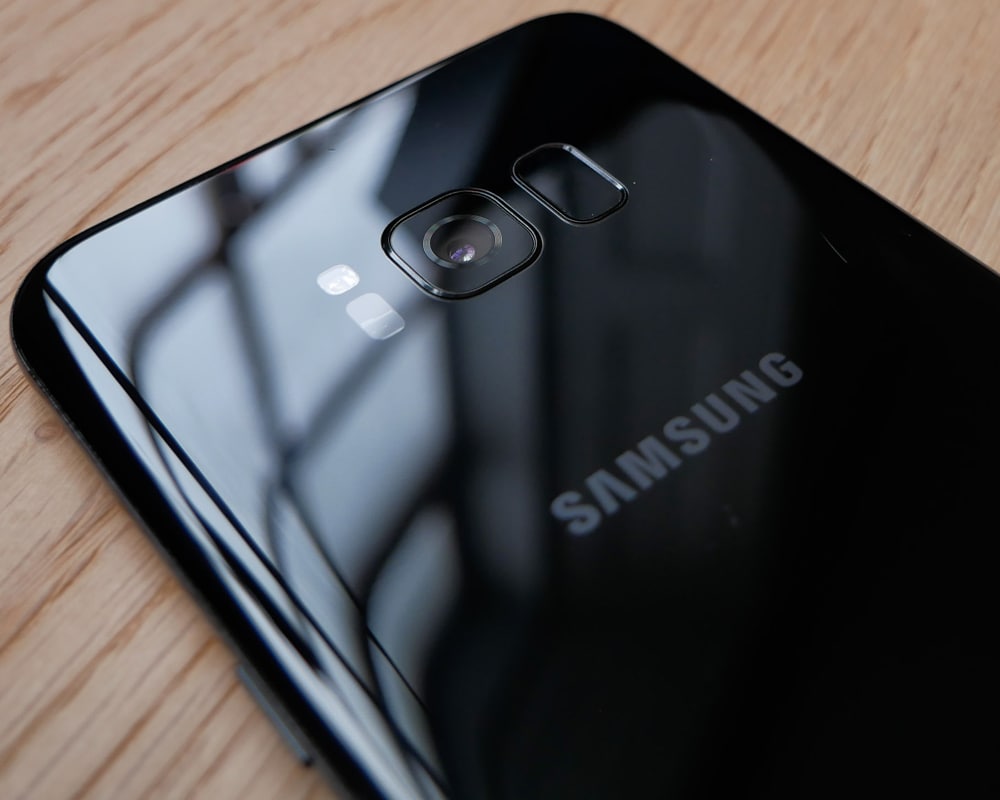
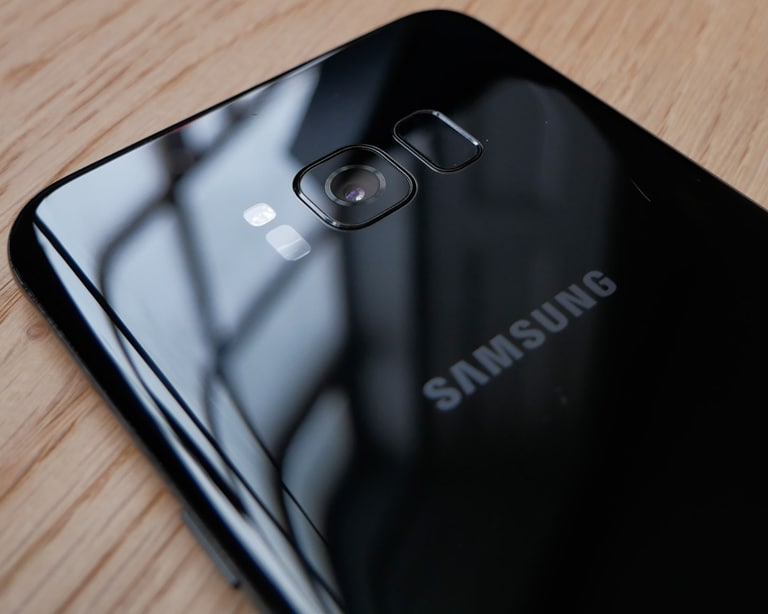
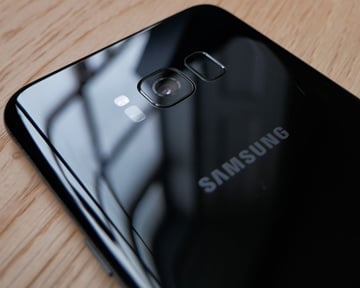
Although this is not the only way to unlock. The smartphone knows its owner by sight.
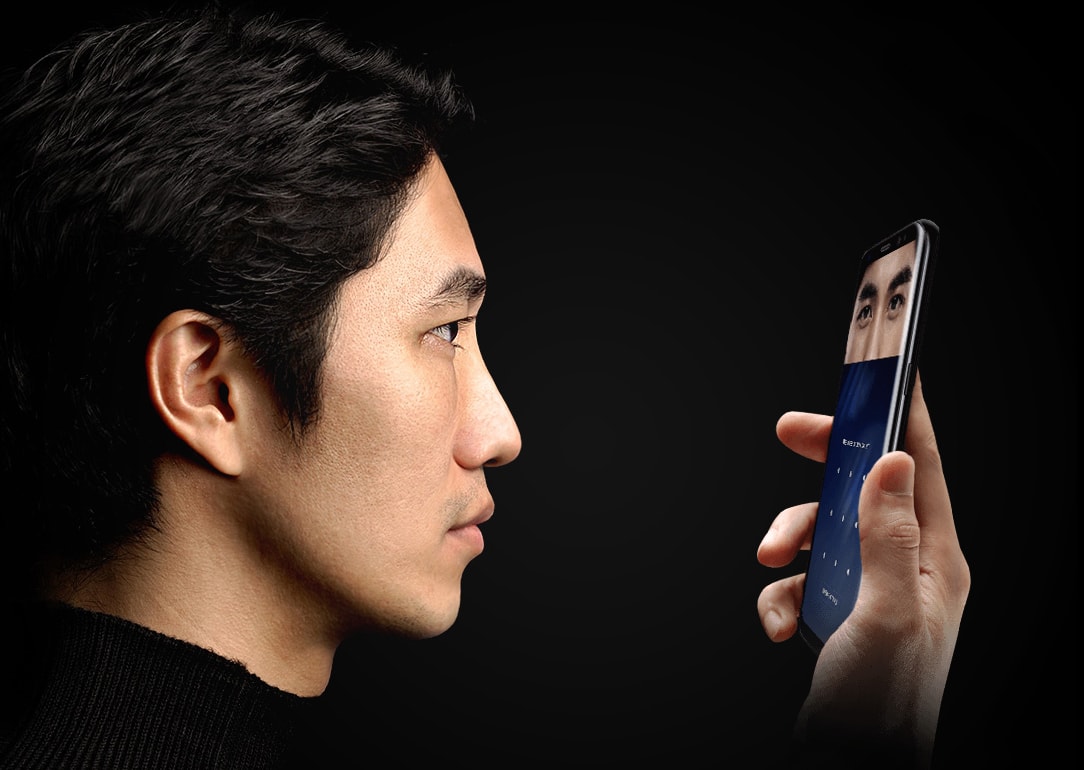
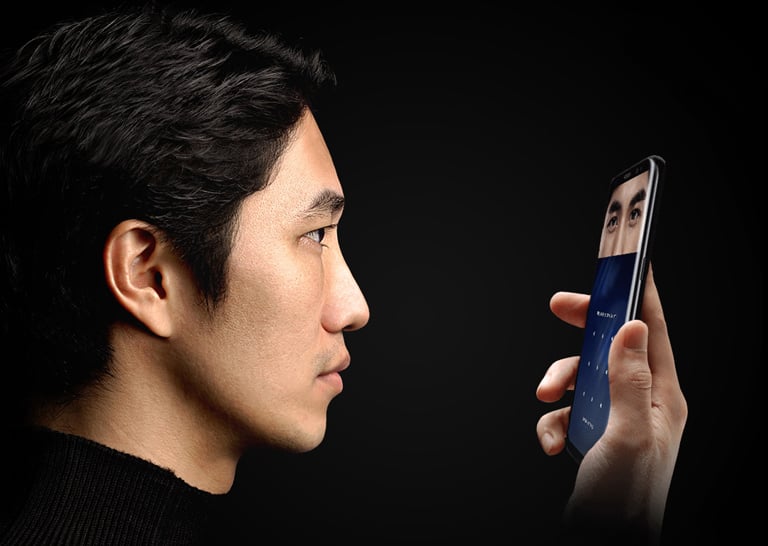
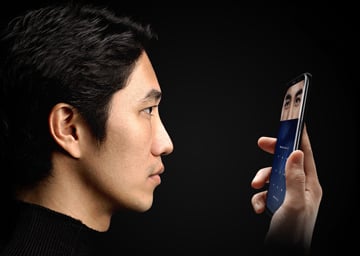
This means that authentication can be based on the eyes (iris scanner) paired with facial recognition algorithms.
Water protection
The smartphone has water protection according to IP68 standard. Just like last year’s flagship. But there was no defense in the top six. In the top five, protection was according to a lower standard IP67.
For comparison, the iPhone 7 has IP67.
Which color should I choose?
Samsung Galaxy S8 has 5 color options:
- Black (Black Diamond)
- Gold (Yellow Topaz)
- Silver (Arctic Silver)
- Lilac or purple (Mystical Amethyst)
- Blue or light blue (Coral Blue)
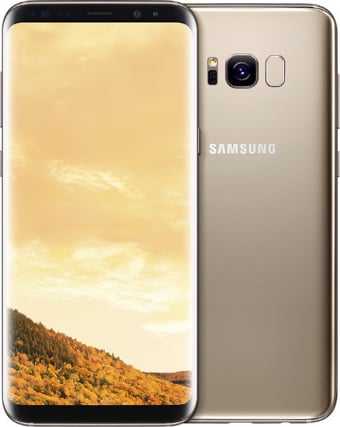
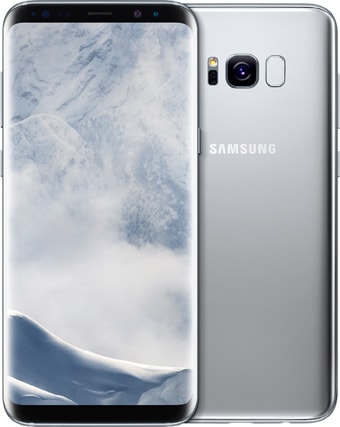
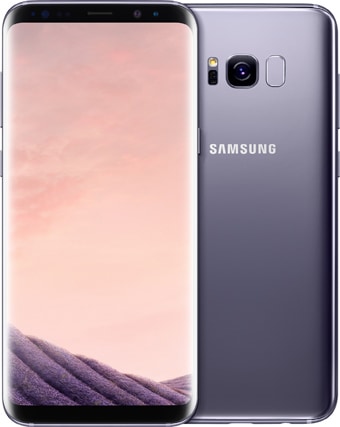
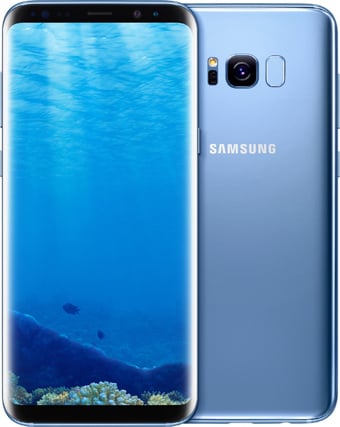
All colors are beautiful. How to choose?
If you do not have a clear preference, then the logic of choice may be as follows. You need to choose a color that is not found in previous flagships, so that no one confuses what kind of thing you have.
Both S7 and S6 are available in black. There is also a gold one here and there. The color silver is in the number seven. Blue is in the six.
This means the winner is “Mystical Amethyst” or lilac color, or you can also call it lilac.
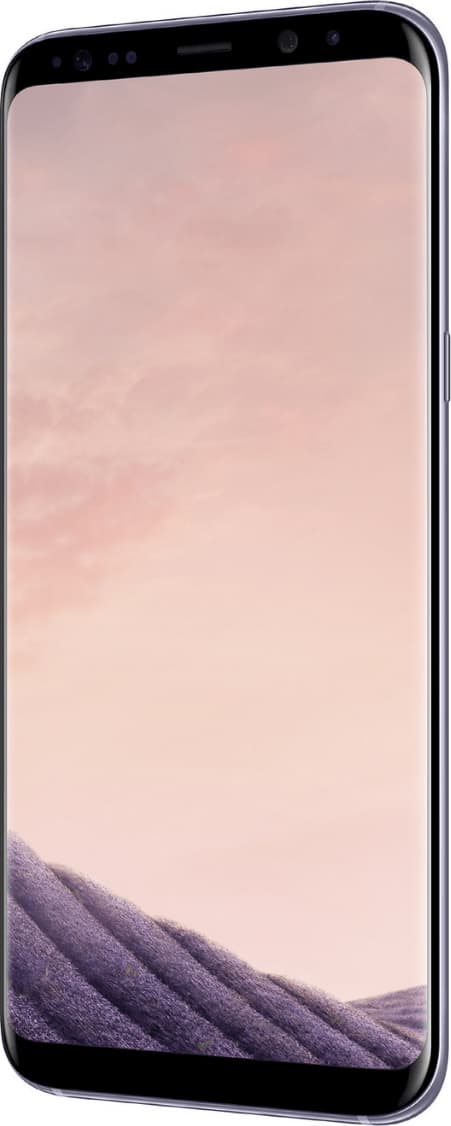
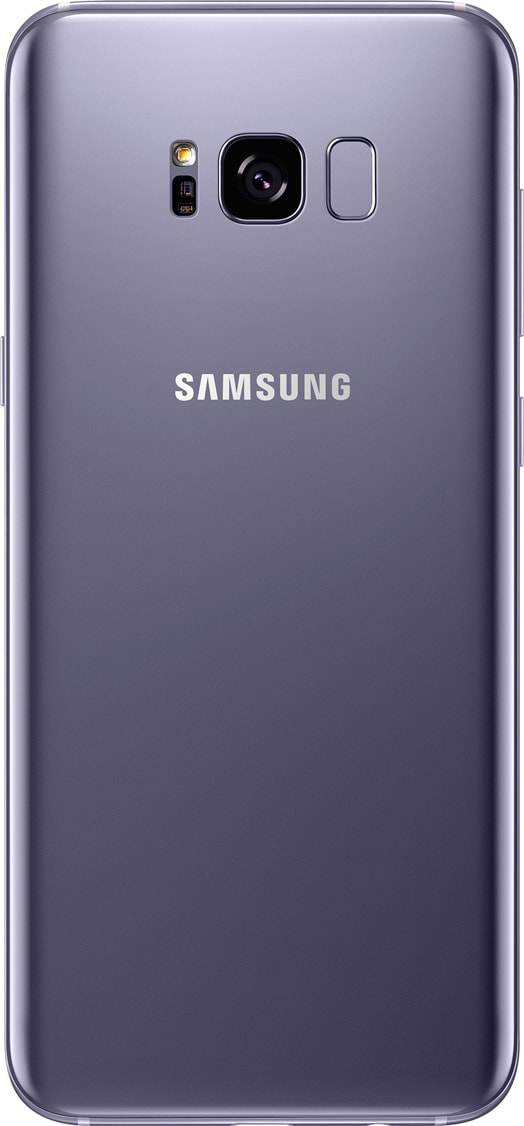
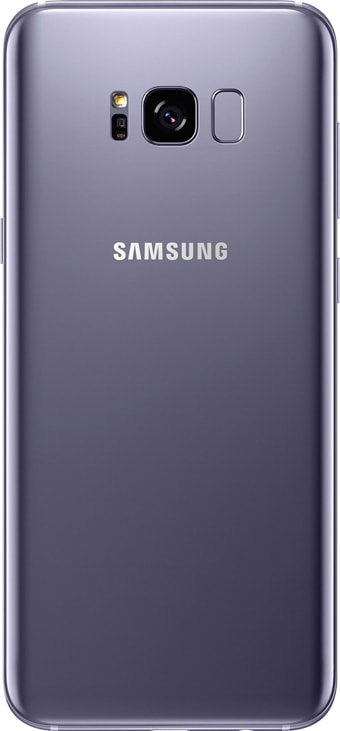
Oh, Mystical Amethyst - you are unique.
Overall, this color is fresh. He hasn't gotten tired of it yet. Agree that black, being a classic color, is too hackneyed.
On the other hand, the appearance of the eighth series is difficult to confuse with anything else, so you can safely take any color.
Screen
As mentioned at the beginning, now both flagship models will have a screen curved on the sides. The screens differ only in size. The S8 has a diagonal of 5.8", and the S8 Plus has a diagonal of 6.2".
It is worth recalling that the previous pair of flagships had display sizes of 5.1 inches and 5.5 inches. It turns out that the regular eight has a larger display than the “advanced” seven.
The displays of both eights are called “ Infinity Display" “Infinity” is translated as “infinity”, “limitlessness”. I don’t know how “Display” is translated.
Apparently, the word “Infinity” seems to hint at the fact that the screen is almost limitless and occupies almost the entire front surface area. It even extends onto the side edges, i.e. limitless. Samsung is trying to combine in its flagship big screen and not an overly large body. The front panel area is used very rationally. Even the fingerprint scanner is now on the back. Previously, it was built into the central button (Home key).
Still in use AMOLED display, or rather Super AMOLED, but the structure of the subpixels has changed - the Diamond Pentile has disappeared. Now the number of subpixels per pixel has increased from 2 to 3.
The 2017 flagship became the first smartphone to support the standard Mobile HDR Premium(supports 10-bit video, dynamic range from 0.005 to 540 nits and coverage up to 90% of the DCI/P3 color space).
Resolution QHD+ (2960x1440 pixels). Let me remind you that subpixel resolution has increased by one and a half times. Therefore, it would be incorrect to compare the resolution with previous flagships based on pixels alone.
The aspect ratio is 18.5:9.
This means that the screen has become more elongated.
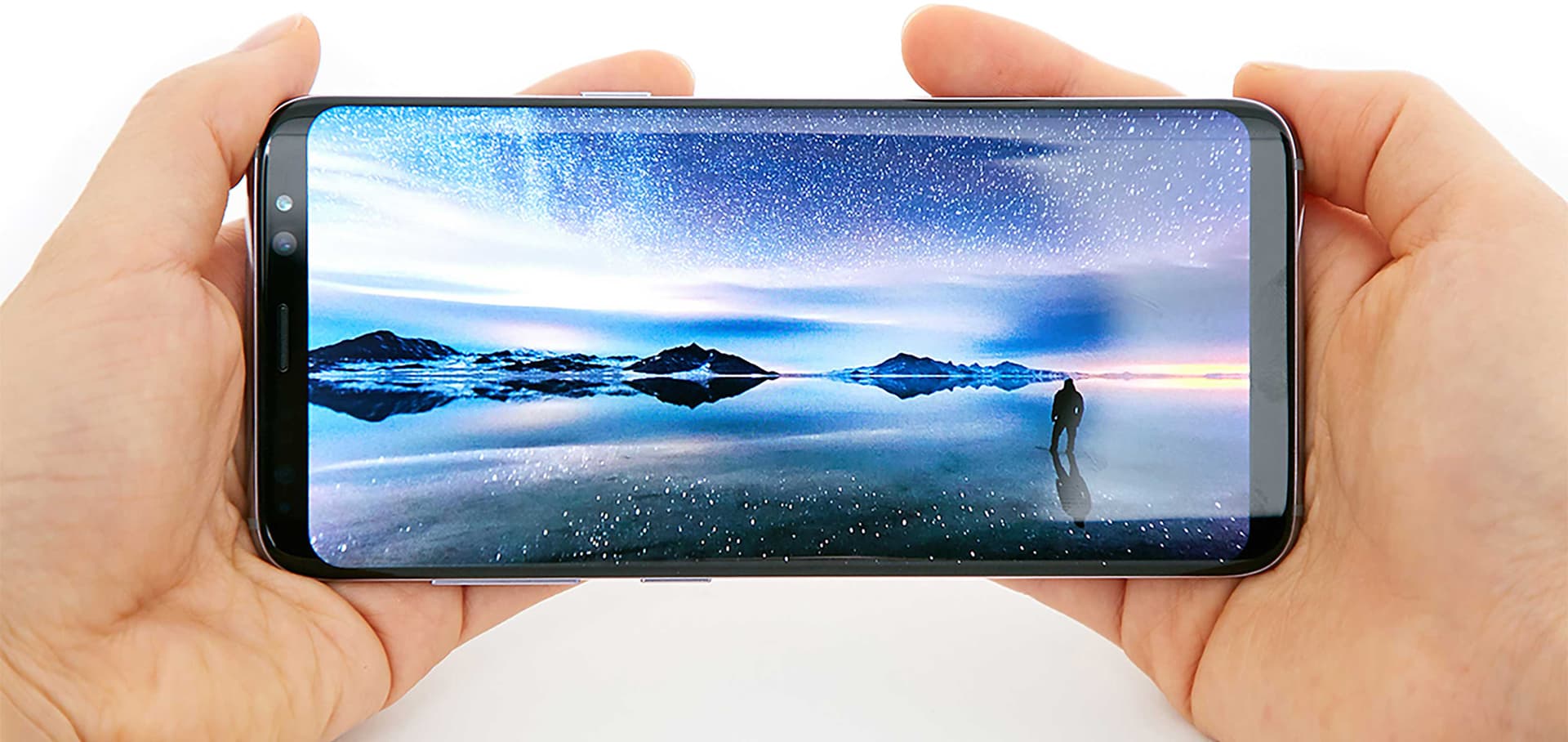

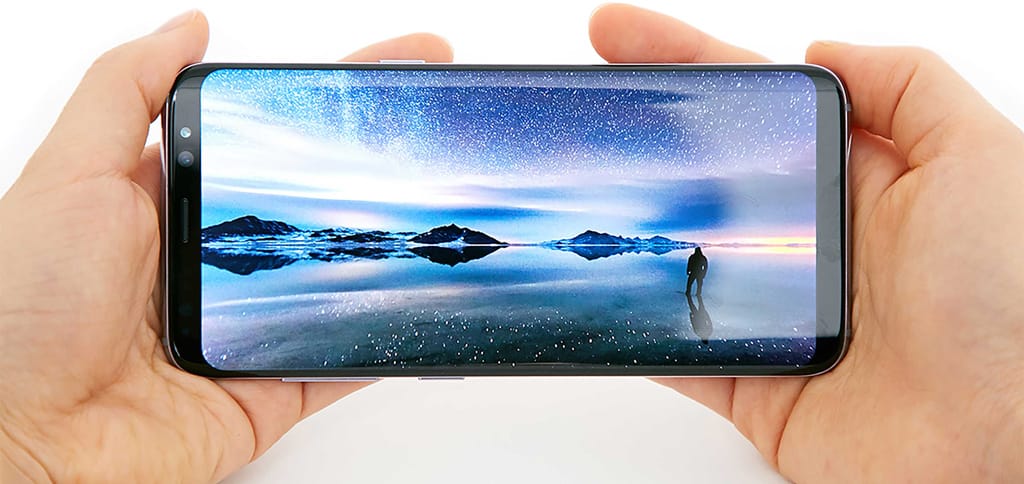
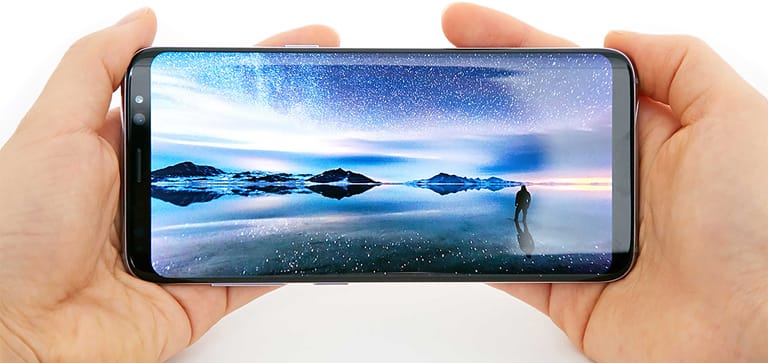
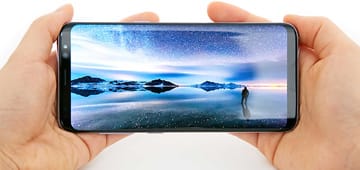
To save energy, you can programmatically set the resolution to FHD+ (2220x1080 pixels) or even HD+ (1480x720 pixels).
Since the matrix is used AMOLED, there is a function " Always On display", which allows you to constantly display basic information on the screen: time, date, missed calls, etc.
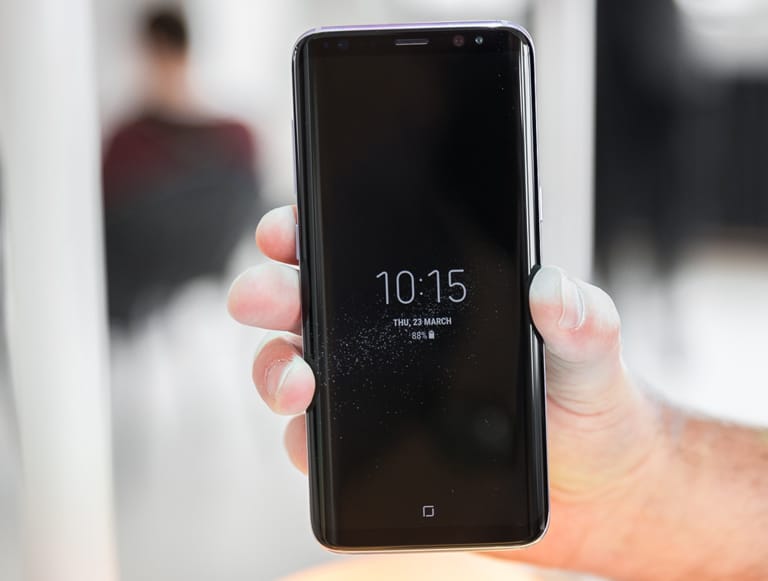
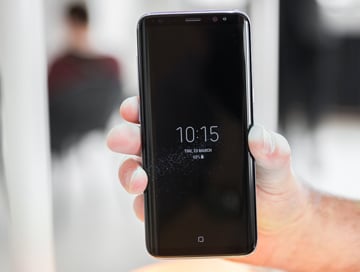
Amoled works in such a way that displaying black does not require energy, i.e. these pixels are turned off. This means that minimal energy is wasted on constantly displaying basic information, since almost the entire screen is off.
A regular display, if it displays at least one pixel, will work completely, accordingly, the battery will be mercilessly eaten.
Scratch-resistant glass is used - Corning Gorilla Glass 5.
Camera
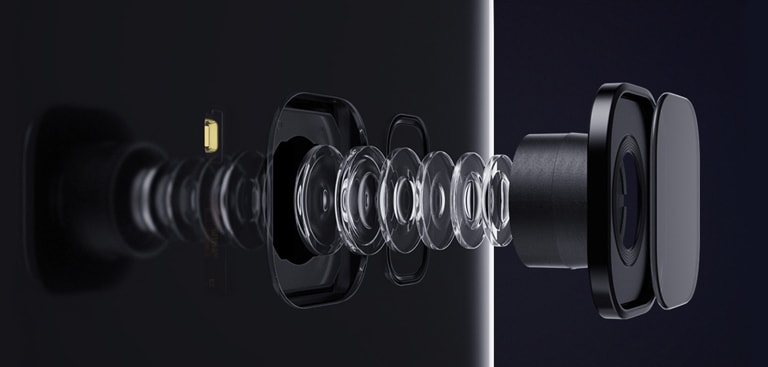
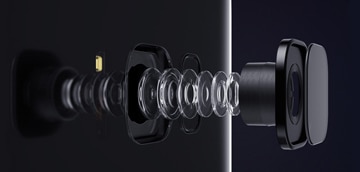
Both the rear and front camera have f/1.7 aperture, which is a very cool indicator. This is one of key advantages cameras.
The main camera is 12 megapixels with Dual Pixel technology.
Dual Pixel is an active phase detection autofocus technology. Each physical pixel of a smartphone camera matrix is equipped with a separate focusing sensor. This means that the camera has 12 million phase sensors for focusing. This allows for almost instant focusing.
The larger the camera’s aperture is open (the smaller the number after “f”, i.e. at f/1.7 the aperture is open more than at f/2.0), the smaller, under all equal conditions, the depth of field (depth of field). This translates into the possibility of getting blurry background(bokeh), which will highlight the subject.



Bokeh is also affected by the physical size of the photo matrix.
This effect is easy to achieve with a professional DSLR camera and often simply impossible on soap boxes.
Of course, you shouldn’t count on the bokeh of a full-size sensor from a smartphone camera, but the flagship can already show at least something.
So, the smaller the depth of field, the more important good autofocus becomes. Because for a large depth of field, autofocus is not needed at all. For example, in some Nokia models At one time, EDoF (Extended Depth of Field) technology was used, i.e. the camera focus was fixed at the hyperfocal distance, plus there was also software processing, to further expand the depth of field. As a result, the entire field was sharp except for a few tens of centimeters from the camera. So there might have been some problems with the macro photography, but everything beyond that was sharp. Consequently, autofocus was not needed - the price of the device decreased, the dimensions decreased, and the shooting speed increased.
With a small depth of field, the camera needs to tune in to the subject being photographed. And if the autofocus misses, then what was needed may not be sharp at all, but what is needed may turn out to be blurry. If the camera doesn't even miss, it will take time to aim, which may result in missing the right moment.
Dual Pixel with its 12 million focusing sensors makes this focusing almost instantaneous.
The physical size of the main photo matrix is 1/2.55". The indicator is not very good, i.e. the matrix is quite small. Namely, the physical size of the matrix is key, and not the number of megapixels.
Photo pixel size is 1.4 microns.
There is optical stabilization.
There is a flash, which is more correctly called a backlight, since it is based on LED lighting and cannot provide as much light as, for example, a xenon flash.
It all sounds quite impressive, but this was already in last year’s flagship. Therefore, there is nothing new in the camera department.
The video camera can record in 4K resolution.
Available software function object recognition.
The front camera has a resolution of 8 megapixels. Matrix size 1/3.6". Pixel size – 1.22 microns.
CPU
Both Snapdragon and Exynos have 8 cores, where some 4 cores are more powerful, and the other 4 are more economical. This is done to make the device more economical for simple tasks.
"Russian" Exynos 9 Octa 8895 have clock frequency 2.3 GHz for powerful cores and 1.7 GHz for economical cores. Has integrated graphics ARM processor Mali-G71.
The Snapdragon 835 has an integrated Adreno 540 GPU.
The processors (both Snapdragon 835 and Exynos 9 Octa 8895) are manufactured on a 10nm process.
Speed central processor increased by 11% compared to the flagship of the previous generation. And the graphics accelerator will speed up by 23%.
RAM
RAM in the new generation will be the same 4 GB. It is noteworthy that the Chinese Galaxy S8 will receive 6 GB of RAM.
Persistent memory
Built-in memory 64 and 128 GB.
Plus it is possible to use microSD card up to 256 GB.
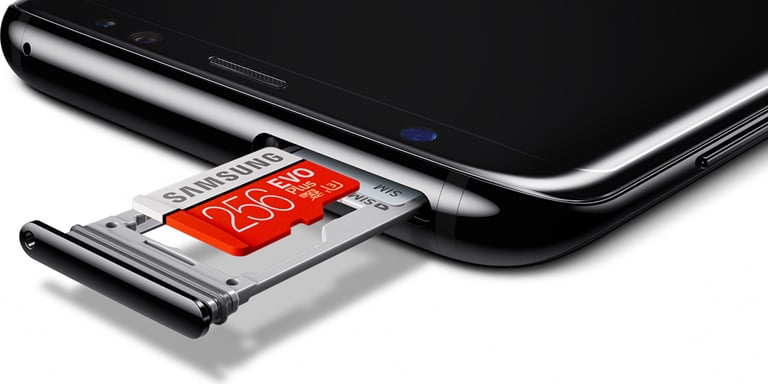
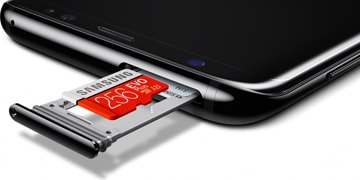
DeX Docking Station
You may remember the Microsoft Display Dock. This is a docking station for smartphones Microsoft Lumia 950 and Lumia 950 XL. It was necessary to connect the smartphone to the docking station, and the docking station to the monitor, keyboard and mouse. operating room Windows system 10 Mobile had a Continuum mode to turn your smartphone into a desktop PC. Well, as if to a desktop PC. Because of this “seemingly” the model failed. The idea is good, but you won’t get a full-fledged Windows from such manipulations.
Microsoft promoted this feature as the main one. A year and a half after Microsoft, Samsung also makes a similar docking station, calling it DeX (desktop extension). True, here this is not emphasized as the main advantage, but rather as one of the features.
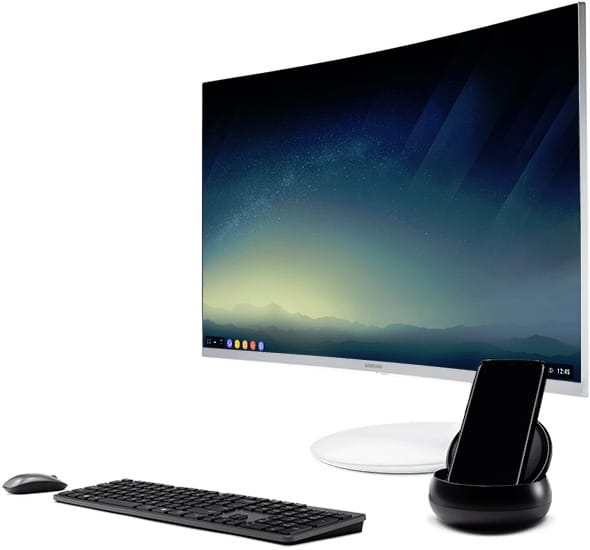
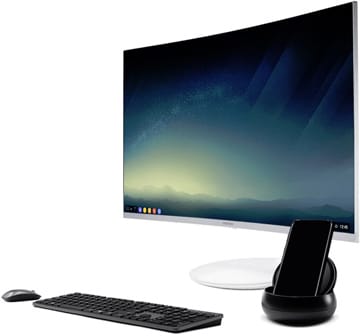
The Koreans' system looks more interesting - they don't have as many wires as the Americans. If you don’t need to plug or connect anything anywhere, then the function can really be convenient. For some task you need to use a large screen and a mouse and keyboard - put your smartphone in a special docking station and you're done. No need to wait for loading operating system, because the whole system is in the phone, and it is always on. And work can be either at a desk with a large monitor or lying on the sofa with a smartphone. And this whole change will happen almost instantly, when there is no need to do any synchronization and there is no need to use the cloud to store data, because with any method of work everything happens on one device.
In my opinion, when advertising DeX, the emphasis should be not on the fact that a smartphone will replace a PC (as Microsoft tried to do), but on the fact that a smartphone can be turned into almost a PC very quickly. It is the speed of transformation that is most interesting here.
With DeX, you don't need to process videos, work with 3D, or create masterpieces in Photoshop. This is a device for quick and not very complex operations, the need for which appeared instantly, but which are inconvenient to perform on a smartphone.
Bixby
Siri can be considered a distant ancestor of Bixby. Siri (Speech Interpretation and Recognition Interface) is Apple's cloud-based personal assistant and question-answering system, introduced on the iPhone. Siri was first third party application from Siri Inc, which could be installed via App Store. Soon Apple company realized the value of such a program and bought Siri Inc. Siri is now an integral part of iOS.
After such a giant as Apple took up Siri, attention to the program increased greatly. Analogues began to appear on both iOS and Android. That's exactly what Bixby is. analogue of Siri, but it is possible that the analogue is superior to the original.
Bixby is an electronic assistant that lives on your phone. He even has his own physical button. He knows and understands a lot, but as he communicates with the owner, he also learns in order to help even more effectively.
.Already now, Bixby can, for example, see a building through a smartphone camera and say what kind of building it is, what is in it, when it was built, etc. Or, seeing something, find it on sale.
It’s difficult to say how adequate this animal is yet.
Just for fun, you can imagine that Bixby, seeing something in the camera, will not only find it on sale, but also buy it, because Bixby has Samsung Pay.
Samsung Pay
Since September 2016, Samsung Pay has become available in Russia.
Samsung Pay is mobile payment service. Works wherever you can make a purchase with a regular bank card using contactless technology or magnetic stripe.
Samsung Pay uses only NFC (which many have), but also its own MST technology(Magnetic Secure Transmission– magnetic safe transmission). This allows you to pay for purchases at almost any terminal that accepts bank cards.
Smartphones that support MST technology can create a magnetic field similar to a magnetic stripe signal bank card. Often sellers themselves do not know that this is possible in their store. You might surprise them.
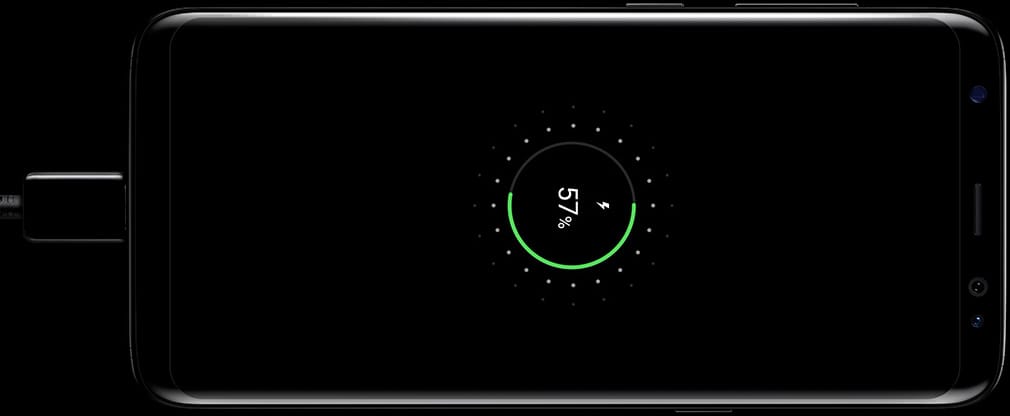
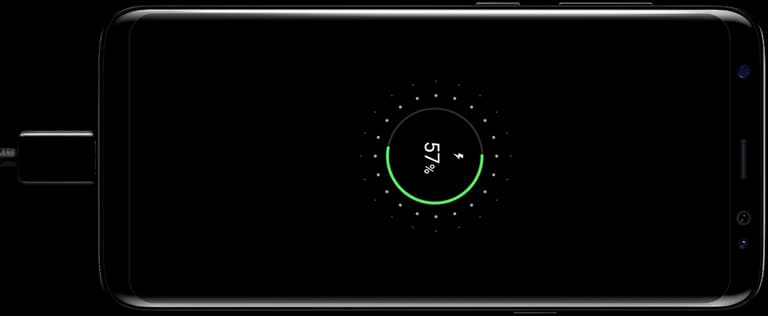
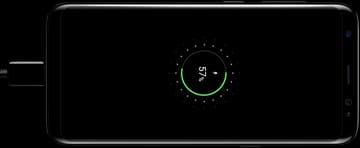
The batteries in the models will have a capacity of 3000 mAh for the regular eight and 3500 mAh for the plus one. This means that the capacity has not increased in comparison with the previous generation, and for the older model it even decreased by 100 mAh.
The display sizes have become larger, the subpixel resolution has increased by one and a half times, the processor has become more powerful... It seems that the operating time without recharging in the Samsung Galaxy S8, and especially in the Galaxy S8+, will become less than in last year’s flagships.
There is a function fast charging. To connect charger Type-C interface is used.
There is also wireless charging.
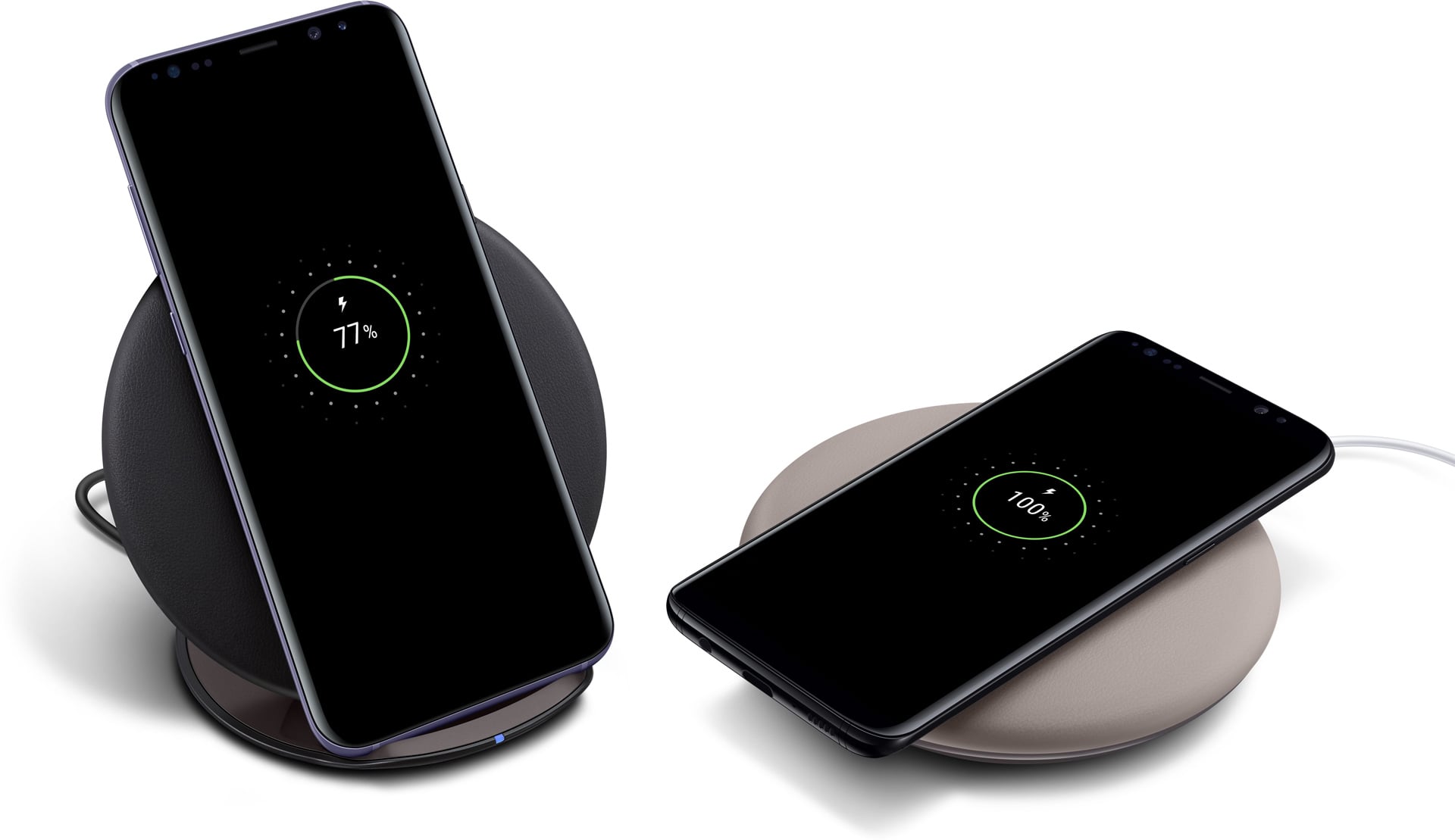
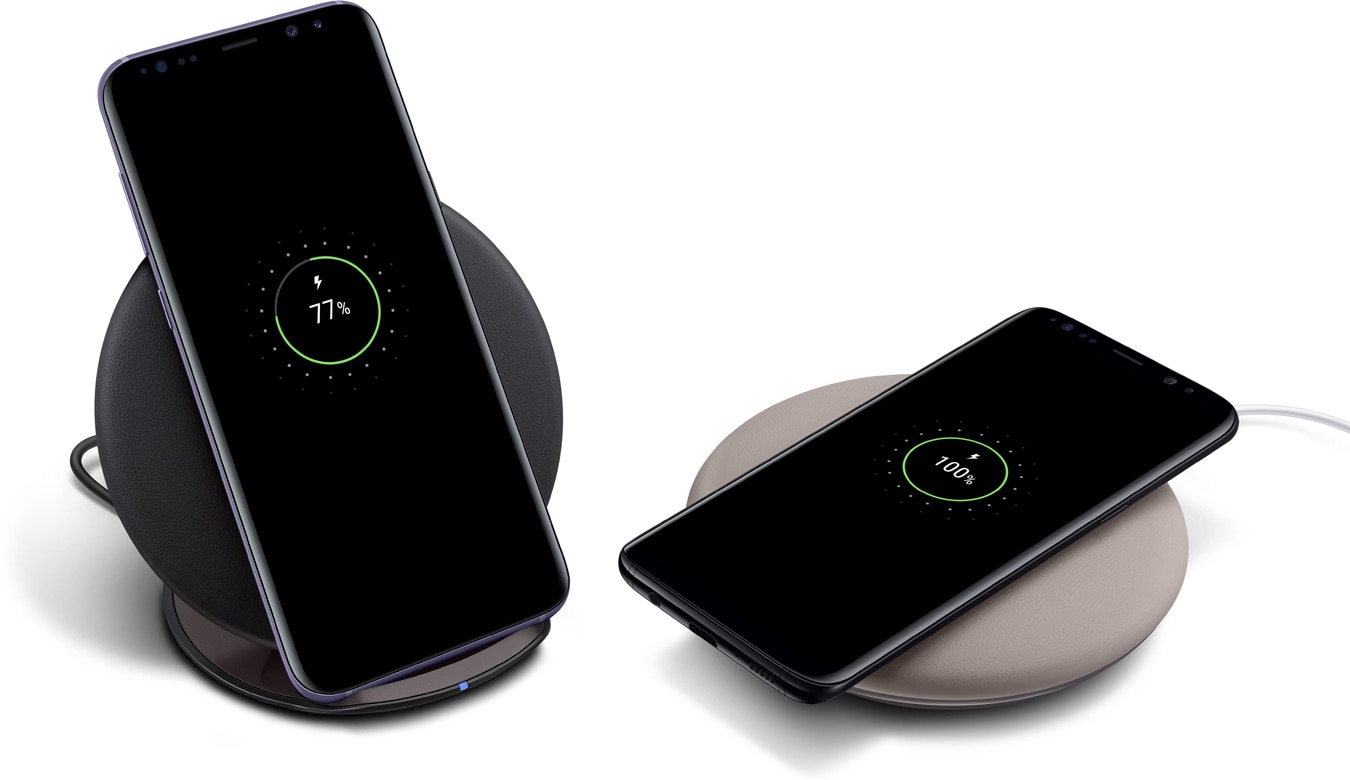
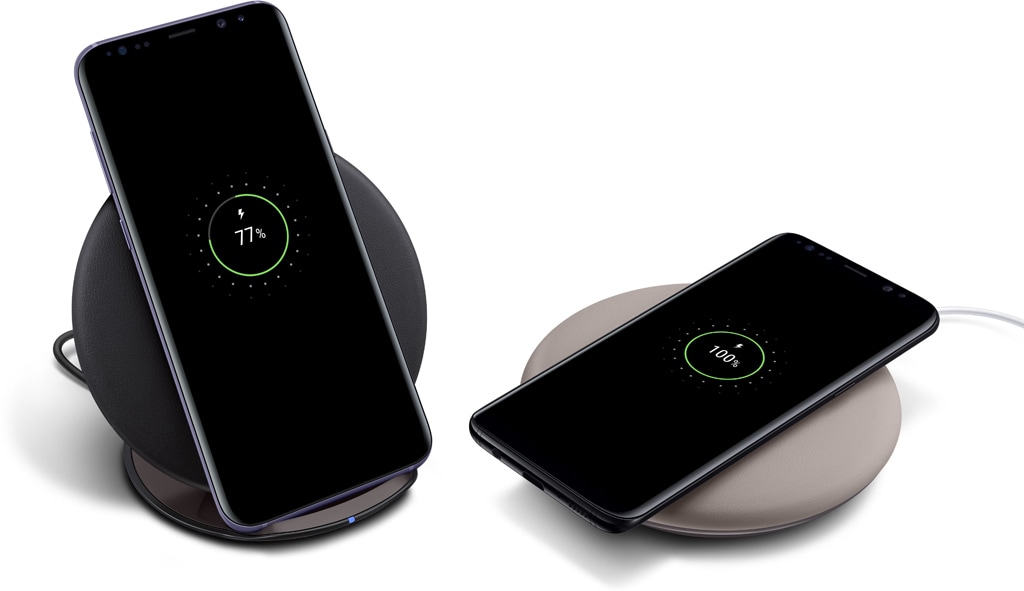
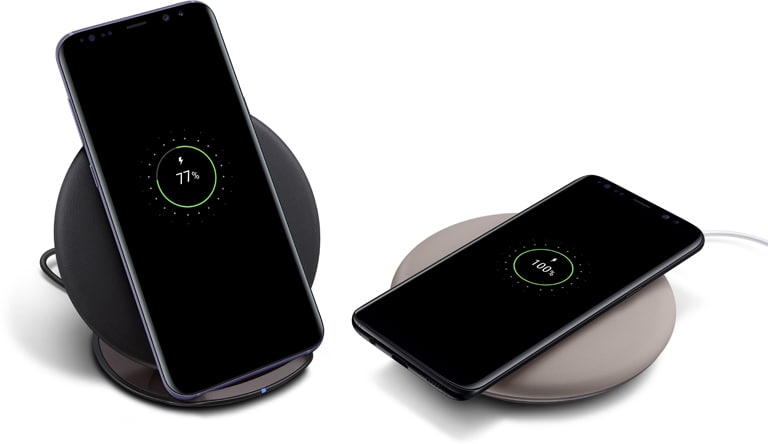
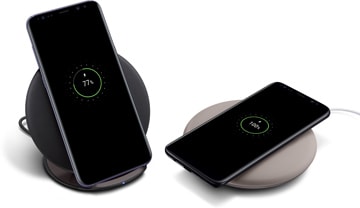
Data interfaces
Following the iPhone, the USB-C interface appeared in the Samsung flagship, but the 3.5 mm jack also remained (it is no longer present in the iPhone 7). This means that you can use standard headphones without using adapters, but there are also opportunities provided by the new USB Type-C 3.1 interface.
There is NFC and MST.
Bluetooth 5.0 LE.
Wi-Fi (802.11a/b/g/n/ac), MIMO (Multiple Input Multiple Output).
Equipment
- Smartphone.
- Wired headset Earphones tuned by AKG.
- Replaceable ear tips.
- USB cable Type-C.
- Mains charger.
- USB adapter (USB Type-C – USB Type A).
- MicroUSB adapter (USB Type-C – MicroUSB).
- Pin for removing the SIM card.
- Quick Guide user & Smart Switch leaflet.
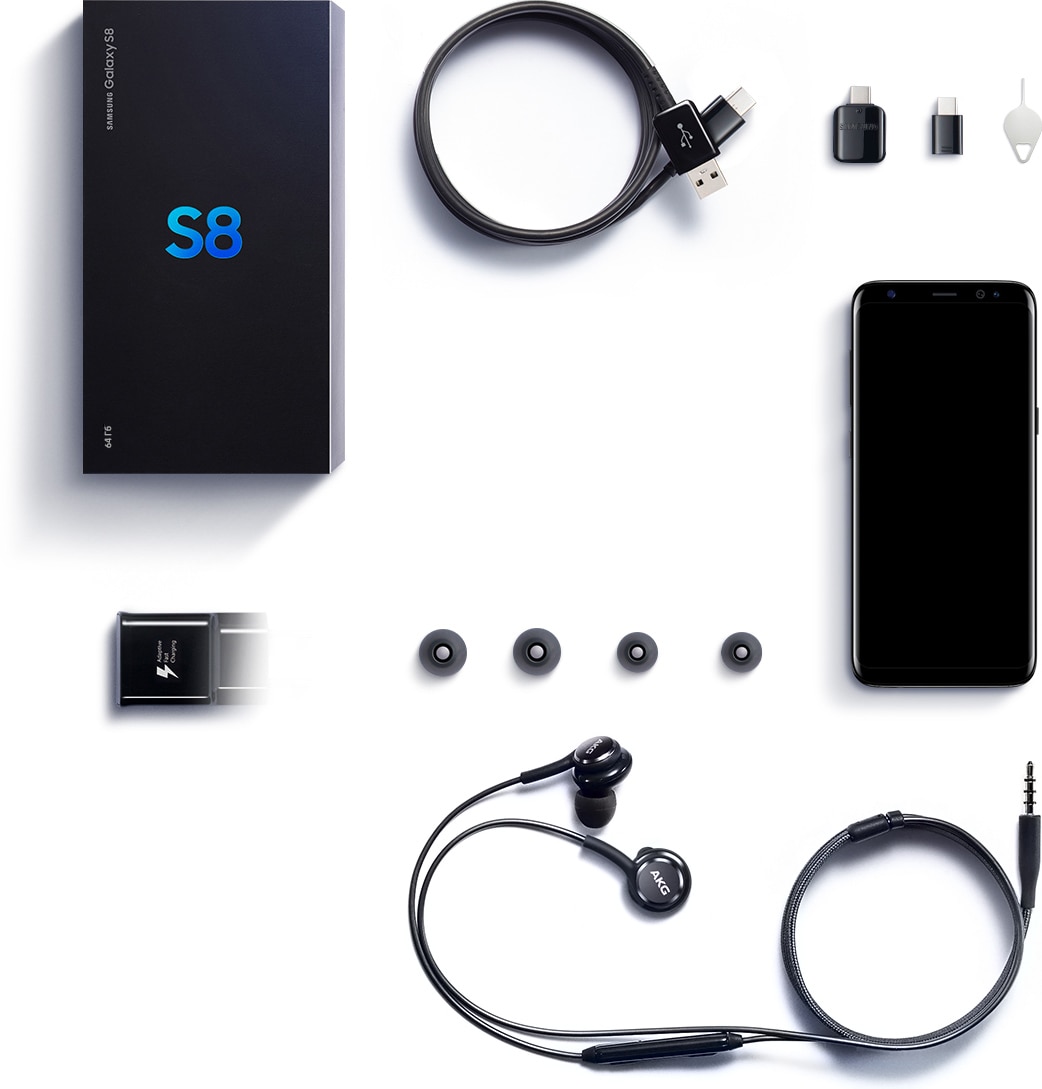
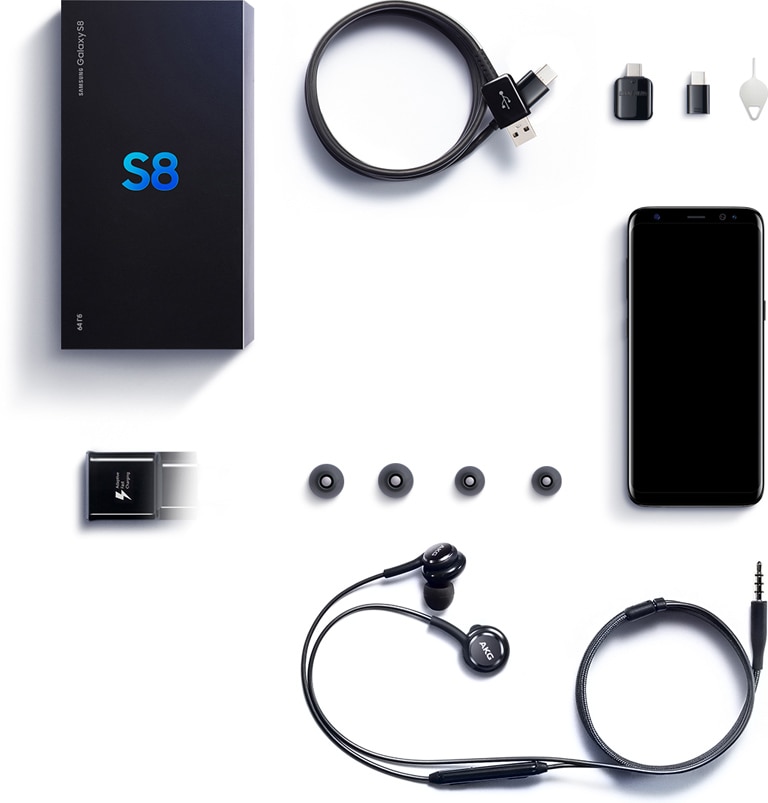
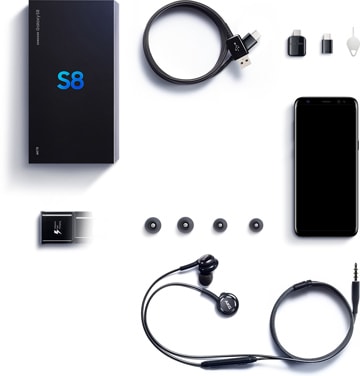
Of particular note are the AKG headphones.
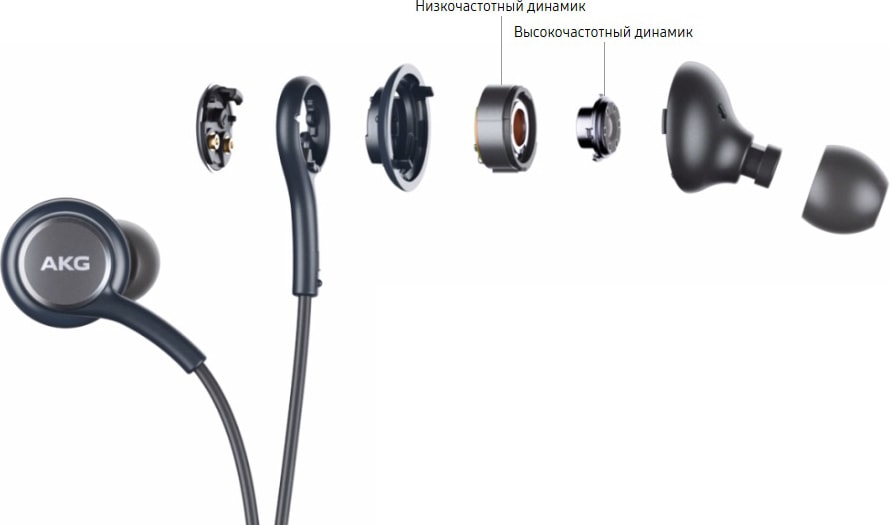
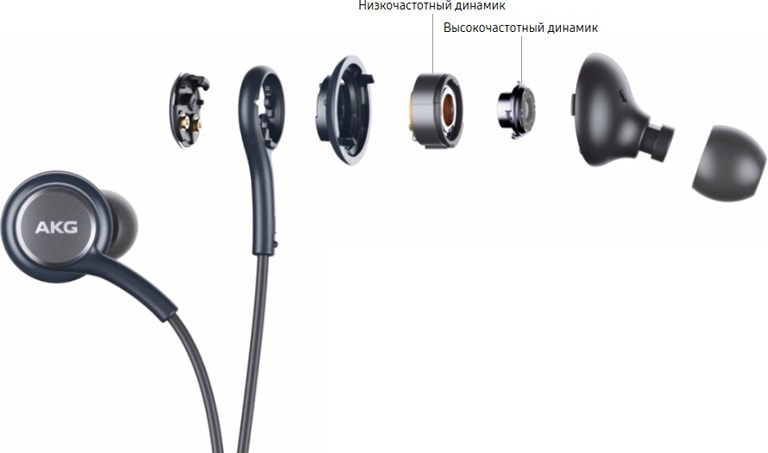
Resume
The main and most noticeable change in the new product is how much space the screen now takes up. It took up more space than ever. At the same time, the dimensions of the phone did not become much larger - only the height (length) increased.
No one will notice the increase in subpixel resolution without a microscope, so this change is not so significant. If you take regular model(not Plus), then the appearance of a curved screen is also significant.
The next significant change follows from the previous one - the transfer of the fingerprint scanner from the front to the back, which in itself is rather a minus.
More productive hardware, but this does not seem to be a very significant innovation.
You might find Bixby assistant helpful. Apparently, Samsung is betting heavily on this.
The smartphone, due to how much space the screen takes up, plus the fact that the screen is rounded, immediately shows others that this is a flagship and a flagship of 2017. Those who like to show off expensive things will love this. After all, some flagships can be confused with more simple models, but in this case it will be difficult to do.
If the screen area to the size of the phone is not such a significant indicator for you, then it makes sense to buy the seventh generation rather than the eighth. By the way, the price for seven should become lower after the appearance of eight.
It can be assumed that the model without the Plus prefix will become more fashionable. The trick is that Samsungs with curved screens were larger than their direct counterparts - S6 Edge, S6 Edge+, S7 Edge, Note Edge. And now you can have such a curved screen on both a larger phone and a smaller one.
If you want a device that is not too large in size and at the same time want to have stylish and expensive rounded edges of the screen, then you will have to fork out for the “regular” Samsung Galaxy S8.